Turkey Hair Transplant
EstheMed Clinic aims to revolutionize treatment and medical care standards for hair transplant Turkey. Operating with a team of doctors with the highest certifications, EstheMed Clinic offers you a safe and reliable environment to get your dream hair.
EstheMed Clinic offers exceptional services to ensure your comfort, including pre- and post-treatment care, luxury services, and most importantly, high-quality medical care.
What makes our services unique is that patients can expect international standards of treatment for their hair transplants in Turkey at affordable costs.
Our EstheMed Clinic procedure has a 99% permanence rate for transplanted hair, so giving you lifetime natural-looking results. Our 7/24 support line will help you anytime you need it and we promise 100% customer satisfaction. Thanks to our sworn translators, we provide services in several languages and have medical aesthetic specialists and dermatologists on our qualified staff.
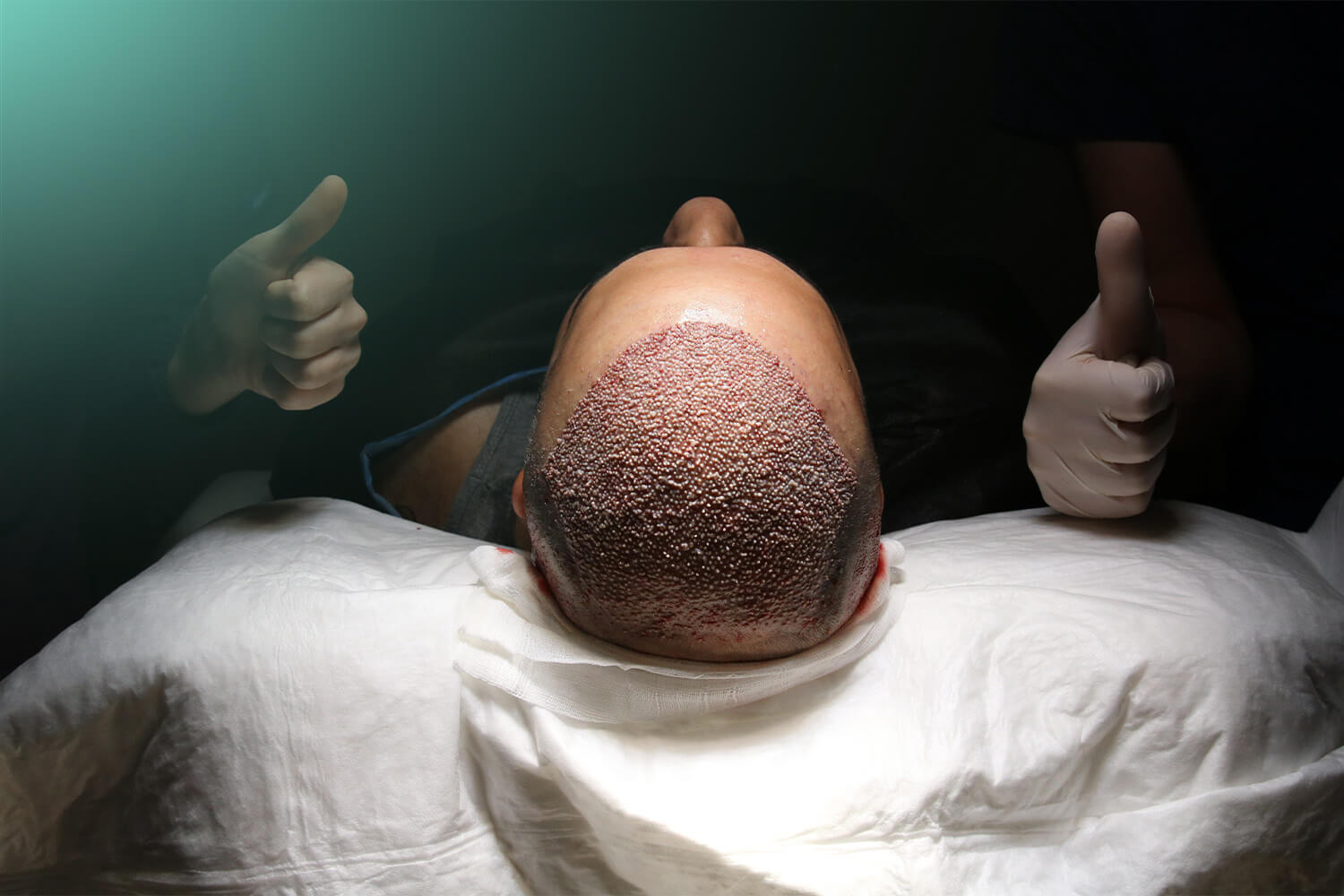
Turkish Hair Transplant
Hair transplant procedures have revolutionized the way people address hair loss, offering a permanent and natural-looking solution. From men seeking to restore a receding hairline to women desiring fuller hair, hair transplantation is a transformative process. Turkey has emerged as a global leader in this field, renowned for its advanced techniques, experienced surgeons, and cost-effective solutions.
Hair transplantation is a sophisticated medical procedure that leverages the body’s natural hair growth patterns to restore hair in areas of thinning or baldness. To fully appreciate the intricacies of this technique, it’s essential to understand the basic biology of hair growth and how transplantation works with these natural processes.
Hair Growth Cycle
Hair growth occurs in a cyclical pattern consisting of three main phases:
Anagen (Growth Phase): This is the active growth phase, lasting 2-7 years. The longer this phase, the longer the hair can grow.
Catagen (Transition Phase): A short transitional period lasting about 2-3 weeks, where hair growth stops, and the follicle shrinks.
Telogen (Resting Phase): The follicle is dormant for about 3 months before the hair falls out, making way for new growth.
Understanding this cycle is crucial in hair transplantation, as surgeons must work with these natural rhythms to ensure the best possible outcomes.
Donor Dominance Principle
The cornerstone of successful hair transplantation lies in the principle of donor dominance. This concept, first proposed by Dr. Norman Orentreich in the 1950s, suggests that transplanted hair retains the characteristics of its origin site rather than adopting those of the recipient area.
In practice, this means that hair follicles taken from areas resistant to balding (typically the back and sides of the scalp) will continue to grow when transplanted to thinning or bald areas. This principle is what makes hair transplantation a viable and long-lasting solution for hair loss.
Follicular Unit Concept
Modern hair transplantation techniques are based on the follicular unit concept. A follicular unit is the natural grouping of hair follicles as they occur in the scalp, typically containing 1-4 hairs along with associated structures like sebaceous glands and nerves.
By transplanting these natural units rather than larger grafts, surgeons can achieve more natural-looking results. This approach mimics the way hair naturally grows and allows for a more precise and aesthetically pleasing distribution of transplanted hair.
Graft Survival and Growth
The success of a hair transplant depends largely on the survival rate of the transplanted grafts. Several factors influence graft survival, including:
- Harvesting technique
- Graft handling and preservation
- Implantation method
- Post-operative care
Skilled surgeons employ meticulous techniques to ensure maximum graft survival, carefully extracting, preserving, and implanting the follicular units to promote optimal growth in their new location.
Understanding these scientific principles provides a foundation for appreciating the complexity and effectiveness of hair transplantation procedures. As we delve deeper into the specific techniques and processes involved, keep in mind that successful outcomes rely on working in harmony with the body’s natural hair growth mechanisms.
Why You May Be Losing Your Hair
Hair loss can occur at any age. Understanding the common causes can help reduce thinning and guide treatment options.
Genetic causes
Male and female pattern baldness, which is linked to genetics and aging, causes hair loss as follicles shrink over time. Predisposed individuals lose fullness earlier than their peers.
Health and Lifestyle Triggers
Diet, stress levels, sleep quality, and styling habits can all have a significant impact on hair health. Significant weight changes, chronic stress, crash dieting, illnesses, and hormonal disorders can all hasten weight loss.
Aggressive daily handling also stresses hair strands. Frequent chemical processing, tight styles, harsh brushing, and heat damage from hot tools can all gradually damage follicles.
Environmental Effects
Toxins in polluted air and water can irritate the scalp and prevent regrowth. Certain medications may also cause side effects. Poor scalp circulation caused by conditions such as anemia limits nutrient intake, and disorders such as fungus and autoimmunity influence hair loss.
Hair Transplant Procedures: How It Works
- Initial Consultation:
- Surgeons assess the patient’s hair loss and determine suitability for procedures like hairline transplant Turkey or full scalp coverage.
- A customized plan is created based on the patient’s goals.
- Hair Follicle Surgery:
- Hair grafts are extracted from the donor area (usually the back of the scalp).
- Techniques like FUE or DHI ensure precision and minimal scarring.
- Implantation:
- Grafts are implanted into the recipient area with great care to mimic natural hair growth.
- Post-Procedure Care:
- Clinics provide detailed instructions for recovery and long-term hair health.
- Follow-ups ensure proper healing and optimal results.
Hair Transplant for Men and Women
Turkey Men’s Hair Transplants:
- Male Pattern Baldness: Male hair transplant surgery addresses receding hairlines, crown balding, and bridge formation.
- Techniques: Hair operation Turkey offers advanced methods tailored to male hair restoration needs.
Turkey Women’s Hair Transplants:
- Women often experience diffuse thinning rather than localized bald spots.
- Hair surgery for women focuses on restoring density and volume while maintaining a natural look.
- Procedures like hair loss surgery for women cater to specific female hair loss patterns.
| FUE DHI Compare | FUE Hair Transplant | DHI Hair Transplant |
|---|---|---|
| Shaving | Complete shaving of the donor area | The recipient area does not need to be shaved |
| Hair Transplant Procedure Time | Shorter in general (because of shaving) | Longest (because it was implanted directly) |
| Hair Transplant Healing Time | 7–10 days for observable healing | Reduced trauma and quicker recovery |
| Implantation Technique | Follicles extracted and then implanted | Direct implantation with a specialized pen |
| Scarring | Minimal dot scarring—usually invisible | There is no scarring (immediate implants) |
| Ideal for | Patients are comfortable with shaving | Precision is required for maximum density |
| Hair Transplant Cost | Middle | Usually highest (result of technique) |
| Precision | High | Highest (because placement is directly controlled) |
| Natural Look | High (varies depending on the surgeon’s expertise) | Most natural depending on direct placement |
| Post-op Care | The typical post-care program for FUE | Minimal touch required, easier recovery |
| Hair Transplant Recovery Time | 1–2 weeks | Less inflammation and a shorter recovery |
Comparison of FUE vs. DHI:
- FUE and DHI both involve extracting individual hair follicles, but DHI offers the advantage of direct implantation, which leads to a more precise procedure and potentially faster healing.
- DHI is considered more advanced because it does not require making incisions beforehand, which minimizes trauma to the scalp.
- Both techniques have similar recovery times, but DHI may offer a slightly more comfortable post-surgery experience.
Summary:
- FUE: Hair follicles are individually extracted and then implanted into the recipient area. It’s widely used and provides natural-looking results with minimal scarring.
- DHI: Similar to FUE but with the added advantage of directly implanting hair follicles using a specialized pen, which provides greater precision and faster recovery.
Both techniques are highly effective for hair restoration and are preferred for their natural-looking results and minimal scarring.
Hair Grafting
- Hair grafting refers to the process of implanting these healthy hair follicles (grafts) into the recipient area.
- Each graft contains one or more hair follicles and is placed into tiny incisions made in the recipient area. The goal is to create a natural hairline and evenly distribute the hair across the transplant area.
- The number of grafts required will depend on the extent of hair loss, and the surgeon will determine how many grafts need to be extracted and placed.
Overall, hair transplant is a highly effective and permanent solution for hair loss, with modern techniques like FUE and DHI ensuring minimal scarring and maximum natural-looking results.
Hair Implants: Cost, Techniques, and Benefits
Hair implants are one of the most sought-after solutions for those experiencing hair loss, whether it’s due to genetics, hormonal imbalances, or lifestyle factors. From understanding the cost of hairline implants to exploring the benefits of procedures like FUE hair implantation, here’s a comprehensive guide to help you make an informed decision.
What Are Hair Implants?
Hair implants are a surgical solution designed to restore thinning or balding areas on the scalp. The procedure involves the extraction of hair follicles from a donor area (usually the back of the head) and implanting them into the balding areas. Both men’s hair implants and women’s hair implants are tailored to individual needs, offering natural and long-lasting results.
Hair Implant Cost
The cost of hair implantation varies depending on several factors, including the clinic, surgeon’s expertise, number of grafts needed, and location. Here’s a general breakdown:
Turkey Hair Implant Cost: Turkey is a leading destination for affordable and high-quality hair transplant surgeries. The hair implant price in Turkey ranges between $1,500 and $3,500, making it a popular choice for medical tourism.
Hairline Implant Cost: Restoring a receding hairline can cost between $1,000 and $2,500, depending on the technique and number of grafts.
Hair Implant Cost for Women: Women’s hair implants may cost slightly more due to the complexity of the procedure and the need for specialized care.
Why Choose Hair Implants in Turkey?
Turkey has become a hub for medical tourism, especially for hair transplantation. Here’s why:
- Best Hair Implants in Turkey: Clinics offer state-of-the-art facilities and highly skilled surgeons specializing in FUE hair implants.
- Affordable Prices: Compared to Europe and the U.S., hair implant costs in Turkey are significantly lower without compromising quality.
- All-Inclusive Packages: Most clinics provide packages that include accommodation, airport transfers, medications, and aftercare services.
Hair Implants for Ladies
Women experiencing hair thinning or bald spots can benefit from hair implantation tailored to their specific needs. Techniques focus on maintaining the natural density and appearance of the hair. Female hair implants are becoming increasingly popular, with many opting for treatments in Turkey due to the affordability and high-quality results.
Before and After Hair Implants
The transformation after a hair implantation procedure can be remarkable. Before and after photos showcase the significant improvement in hair density, natural hairline restoration, and overall confidence. Patients typically start noticing results within 4-6 months, with full results visible after 12 months.
Side Effects of Hair Implants
While hair implants are generally safe, potential side effects include:
- Temporary redness and swelling.
- Mild discomfort in the donor and recipient areas.
- Itching or scabbing during the healing process.
Most side effects subside within a few weeks, and following your surgeon’s aftercare instructions can ensure a smooth recovery.
Whether you’re considering hair implantation for men or women, Turkey offers some of the best hair implants at competitive prices. From hair implants before and after transformations to understanding the cost of hair implant surgery, the key is to choose a reputable clinic with experienced surgeons. Rest assured, with the right procedure, you can restore your hair and confidence effectively.
Contact us today for a free consultation and discover the highest quality hair transplant services in Turkey.
Hair Transplant Techniques
Three different hair transplant techniques are used in EstheMed Clinic. These are FUE Hair Transplant, Sapphire FUE Hair Transplant and DHI Hair Transplant. Micro-pencil tips one at a time remove healthy hair follicles one during the FUE hair transplantation operation and then put them to a designated solution. This helps the one at a time channels to open and preserves their lives.
Sapphire FUE hair transplants differ from FUE only in the micro-motor pen tip. This material helps to reduce any developing scalp rashes. The health and allergic situation of the patients also affect their choice for this drug.
An enhanced form of the FUE hair transplant surgery is the DHI hair transplant surgery. One by one we pluck healthy hair follicles and implant them with microtips in line with the defined natural hairline. Since in this situation there is no need to open the channel, the operation takes less time than others. Modern DHI hair transplant techniques devoid of channel opening condition demonstrate nothing.
The hair structure of the patient usually determines how well each hair transplant operation goes. The patient can finish the operation standing and chatting with the experts under local anesthetic. Before, during, and after the operation, we administer local anesthetic to help you not feel any pain. Operations involving hair transplants come to an end in a 6–7 hour period.
Hair Transplant Procedures (FUE and DHI)
Here’s a breakdown of the FUE (Follicular Unit Extraction) and DHI (Direct Hair Implantation) techniques for hair transplant procedures, as these are the most modern and preferred methods:
- Initial Consultation
- The first step is a consultation with a hair transplant specialist to assess the extent of hair loss, determine the best treatment plan, and ensure you are a good candidate for hair transplantation.
- During this consultation, the surgeon will also evaluate the donor area (where hair will be taken from) and recipient area (where hair will be transplanted).
- Preparation
- On the day of the surgery, the donor and recipient areas are thoroughly cleaned.
- Local anesthesia is applied to both the donor and recipient areas to ensure there is no pain during the procedure.
FUE (Follicular Unit Extraction)
FUE is one of the most advanced and widely used hair transplant techniques today. Here’s how it works:
Step-by-Step Process of FUE:
- Extraction of Hair Follicles:
- In FUE, individual hair follicles are extracted directly from the donor area using a specialized punch tool(typically ranging from 0.7mm to 1mm in diameter).
- Each follicle is carefully removed without creating large incisions or a linear scar, leaving behind tiny, dot-like scars in the donor area that are less noticeable.
- Preparation of Grafts:
- The extracted follicles are prepared under a microscope, where they are categorized and sorted to ensure optimal placement based on the number of hairs per follicle (1, 2, or 3 hairs per graft).
- Implantation of Follicles:
- The follicles are then implanted into small incisions made in the recipient area, following the natural direction and angle of hair growth for the most natural appearance.
- The surgeon places the grafts with careful attention to the density, direction, and overall design of the hairline to ensure natural results.
- Post-Surgery Care:
- After the procedure, the patient is provided with instructions for aftercare to ensure proper healing, such as avoiding direct sunlight, not scratching the scalp, and proper washing techniques.
- Results:
- The newly transplanted hair will shed within a few weeks, and new hair growth will start in about 3-4 months, with full results visible in 12-18 months.
DHI (Direct Hair Implantation)
DHI is a more recent and advanced hair transplant technique that builds upon the FUE method but offers even more precision and faster recovery times.
Step-by-Step Process of DHI:
- Extraction of Hair Follicles:
- Similar to FUE, DHI involves the extraction of individual hair follicles from the donor area using a specialized tool.
- However, instead of using a punch tool like FUE, DHI uses a device called the Choi pen, which allows for a direct extraction and implantation process.
- Direct Implantation:
- The key difference with DHI is that the follicles are directly implanted into the recipient area using the Choi pen, which holds the hair grafts and places them immediately into the recipient area without the need for creating incisions beforehand.
- This method ensures greater precision in terms of the depth, angle, and direction of the implanted follicles.
- Advantages of DHI:
- No Incisions: Since DHI does not require the creation of incisions in advance, it can reduce the overall trauma to the scalp, resulting in faster healing and less post-operative swelling.
- Higher Precision: The use of the Choi pen allows for more precise placement of the grafts, which can be especially beneficial in areas like the hairline or the crown where a natural look is crucial.
- Natural Results: The direct implantation technique allows for greater flexibility in hairline design and ensures natural hair growth patterns.
- Post-Surgery Care:
- The aftercare for DHI is similar to FUE, but due to the precision of the technique, the healing process is often quicker, with minimal discomfort and less downtime.
- Results:
- Like FUE, the transplanted hair will shed in the first few weeks after surgery. Full results will typically be visible within 12-18 months.
Advanced Techniques for Optimal Results
We utilize three of the most effective hair transplantation techniques: FUE (Follicular Unit Extraction), DHI (Direct Hair Implantation), and Sapphire FUE. Each method offers unique benefits, allowing us to tailor our approach to meet the individual needs of our patients.
- FUE (Follicular Unit Extraction): This minimally invasive technique involves extracting individual hair follicles from the donor area and implanting them into the recipient area. FUE is known for its quick recovery time and natural-looking results, making it a popular choice among patients.
- DHI (Direct Hair Implantation): DHI is an advanced form of FUE that allows for greater precision in hair placement. Using a specialized tool, we can implant hair follicles directly into the scalp without the need for prior incisions. This method promotes higher density and a more natural hairline, minimizing damage to existing hair.
- Sapphire FUE: This innovative technique uses sapphire blades for the incision process, providing increased accuracy and reduced trauma to the scalp. The use of sapphire enhances the overall aesthetic outcome and speeds up the healing process, resulting in less swelling and discomfort for our patients.
Comprehensive Care and Support
At EstheMed Clinic, we prioritize your comfort and satisfaction throughout the hair transplant journey. From the initial consultation to post-operative care, our experienced team is dedicated to providing you with a seamless experience.
We conduct thorough assessments to determine the most suitable technique for your specific needs, ensuring optimal results. Additionally, our all-inclusive packages cover everything from pre-operative consultations and accommodations to 24/7 support, so you can focus on your recovery and enjoy your time in Turkey.
Transform Your Life with EstheMed Clinic
Hair loss can be a challenging experience, but at EstheMed Clinic, we believe that everyone deserves to feel confident in their appearance. Our high-quality hair transplant procedures, combined with our commitment to patient care, set us apart as a leader in the field.
Join the many individuals who have transformed their lives through our expert hair restoration services. Experience the difference at EstheMed Clinic, where your journey to natural-looking hair begins.
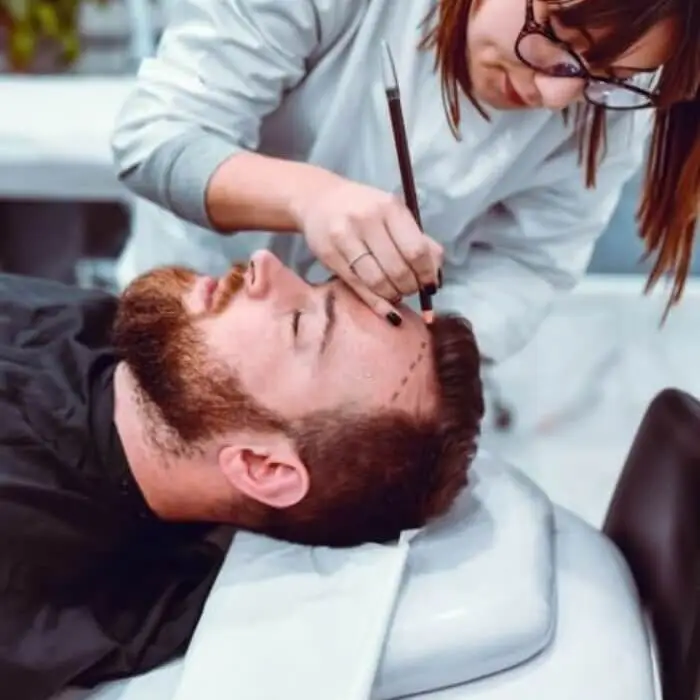
FUE Hair Transplant is a cutting-edge method that is available at EstheMed Clinic. We try for maximal grafts with outstanding and natural results using our FUE procedure. This novel method to hair transplantation ensures that each patient receives a customized treatment plan adapted to their individual requirements.
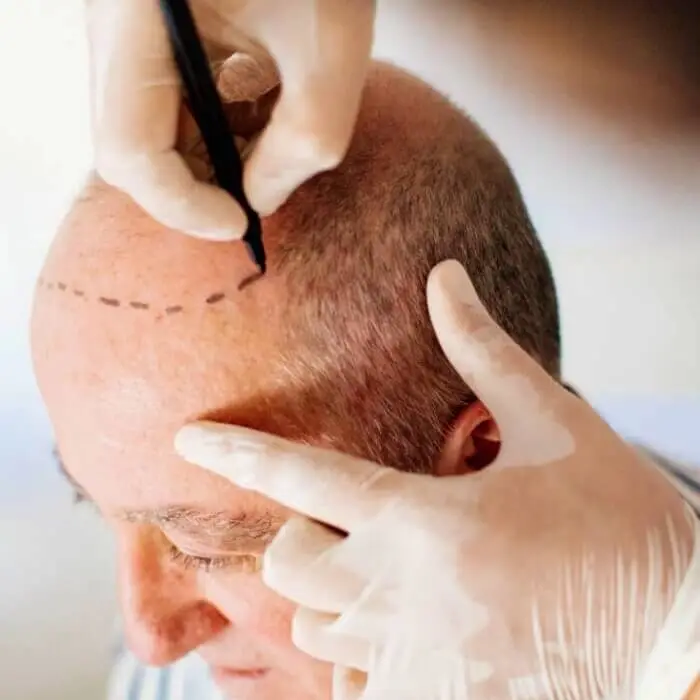
DHI, a cutting-edge hair transplantation method, is available at EstheMed Clinic. This innovative technique involves removing individual hair follicles from the donor area using a specialized tool known as a Choi pen, which allows for precise and controlled placement of the grafts into the recipient area.
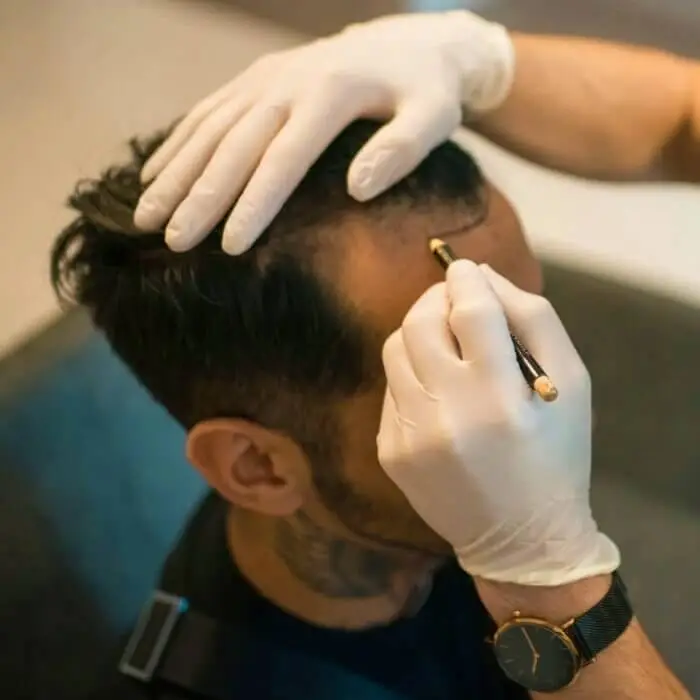
At EstheMed Clinic, we strive to give our patients the most natural-looking outcomes possible. Our team of experts uses cutting-edge equipment and technology to perform Sapphire FUE, guaranteeing that each patient receives specialized therapy tailored to their specific needs.
Before Operation, Pre-procedural Advice:








After Operation, Post-procedural Instruction:









Best Hair Transplant in Turkey
When it comes to hair transplant clinics in Turkey, EstheMed Clinic stands out as one of the best. Recognized for its professional certifications, advanced technology, and personalized treatment plans, EstheMed Clinic has established itself as a leading hair transplant clinic in Turkey. With a high rate of success in hair transplant surgeries, the clinic is renowned for delivering natural-looking results, excellent patient satisfaction, and specialized services for international patients.
With Turkey leading the global market in hair transplant surgery, patients can confidently choose the country for their best hair loss treatment. Whether it’s hair transplantation for females, male hair transplant surgery, or hair surgery for women, the combination of expertise, affordability, and advanced techniques makes Turkey the ultimate destination for hair restoration.
Top-Rated Hair Transplant Clinics in Turkey
Turkey is home to clinics renowned for providing the best hair transplant surgery in Turkey and top-rated hair transplant services. These facilities offer:
- Hairline Transplant Turkey: Precise restoration of natural hairlines.
- Hair Follicle Surgery: Advanced methods for natural-looking results.
- Hair Transplantation for Females: Customized solutions for women facing hair loss.
Why is Turkey Leading the Hair Transplant Industry?
A typical hair transplant procedure involves extracting hair from a donor area, typically the back of the head (the occipital region), but if necessary, hair can also come from other areas like the beard. We then implant these hair grafts into balding or thinning areas. Experienced technicians and cosmetic surgeons lead the entire process, which typically takes between 6 and 8 hours to complete.
How Do Hair Transplants Work, and What Should You Expect?
Turkey has become a top destination for hair transplants, with increasing numbers of international patients seeking treatment in the country. Turkey, in particular, offers hair transplants with a high success rate and significantly lower prices compared to many other countries, making it an attractive option for those seeking effective yet affordable solutions.
Best Turkish Hair Transplant
EstheMed Clinic is among the top hair transplant clinics in Turkey, backed by a highly experienced medical team. The clinic specializes in cutting-edge techniques such as FUE, DHI, and Sapphire FUE and is located in Turkey. Known for crafting individualized treatment plans tailored to each patient’s unique needs, EstheMed ensures natural results with minimal recovery time. Thanks to its state-of-the-art technology and dedicated patient care, the clinic has welcomed thousands of international patients seeking affordable yet safe hair transplants. Whether dealing with hair thinning, balding, or a receding hairline, EstheMed Clinic is committed to providing exceptional care and long-lasting results.
Is a Hair Transplant Turkey Painful?
Generally, hair transplant procedures in Turkey, like elsewhere, are not considered particularly painful. The procedure minimizes pain by applying local anesthesia to numb the scalp. The injection of the anesthesia may cause a brief feeling of slight discomfort. After the surgery, patients might experience some tension in the scalp as the anesthesia wears off, but this is typically manageable with over-the-counter painkillers recommended by the doctor. Most patients report that the experience is more uncomfortable than painful, and recovery is usually smooth. The level of discomfort may also vary slightly depending on the technique used—whether Follicular Unit Extraction (FUE) or Direct Hair Implantation (DHI)—but both methods are generally associated with minimal pain.
Is it Safe to Have a Hair Transplant Turkey?
As long as you choose reputable clinics, hair transplants in Turkey are generally safe. Turkey is a top destination for hair transplants due to its highly skilled surgeons, advanced techniques, and affordable pricing. However, it’s essential to carefully select the clinic and surgeon to ensure your safety.
Here are some factors to consider for a safe experience:
- Accredited Clinics: Opt for licensed clinics that adhere to medical standards, with certifications from reputable national and international medical organizations.
- Experienced Surgeons: Ensure that the surgeon performing your procedure is an experienced professional with specialized expertise in hair transplantation.
- Advanced Techniques: Leading clinics use state-of-the-art techniques like FUE and DHI, both of which are minimally invasive and deliver excellent results.
- Hygiene and Safety Standards: Reputable clinics maintain high hygiene standards that meet international health guidelines.
- Pre- and Post-Operative Care: Good clinics provide thorough consultations before the procedure and comprehensive post-operative care to support recovery.
- Positive Reviews and Testimonials: Check the clinic’s reputation by reviewing feedback from previous patients. Turkey has a wide range of hair transplant clinics, so it’s important to select one that combines quality care with affordability.
Is Turkey a Good Place for Hair Transplants?
Yes, Turkey is considered one of the best places in the world for hair transplants. Some of the reasons for this are:
- Experienced Surgeons: Many Turkish clinics are home to highly skilled surgeons who specialize in hair transplantation, with thousands of successful procedures performed every year.
- Modern Techniques: Turkish clinics employ cutting-edge techniques like FUE and DHI, which ensure minimal invasiveness and optimal results.
- Cost-Effectiveness: Hair transplants in Turkey are significantly more affordable compared to those in countries like the US, Canada, and across Europe, without compromising on quality.
- Comprehensive Packages: Many Turkish clinics offer all-inclusive packages for international patients, covering the procedure, accommodation, post-operative care, and transportation.
- Medical Tourism Infrastructure: Turkey has a well-established medical tourism system, with services designed to assist foreign patients, including help with visas, English-speaking staff, and logistical support.
- Proven Results: Turkey is widely recognized for its expertise in hair transplantation, with numerous international patients sharing positive experiences and successful outcomes.
In conclusion, Turkey is an excellent choice for hair transplants, offering an ideal combination of quality, affordability, and convenience.
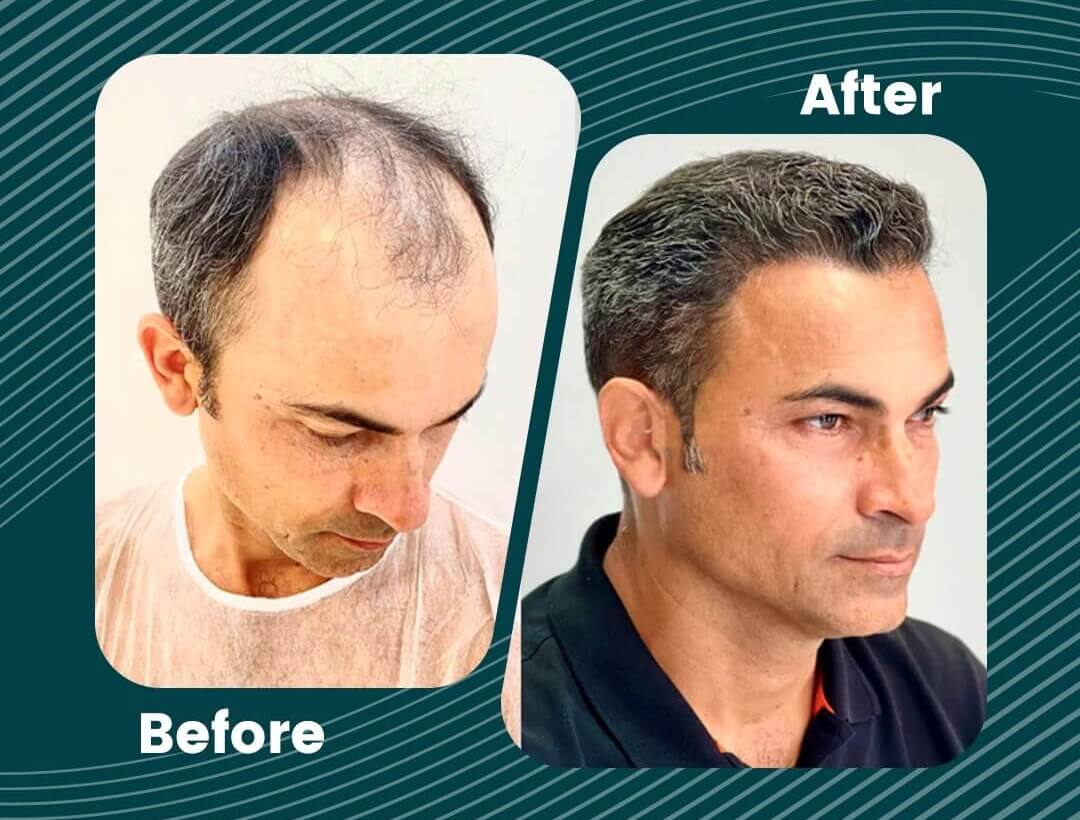
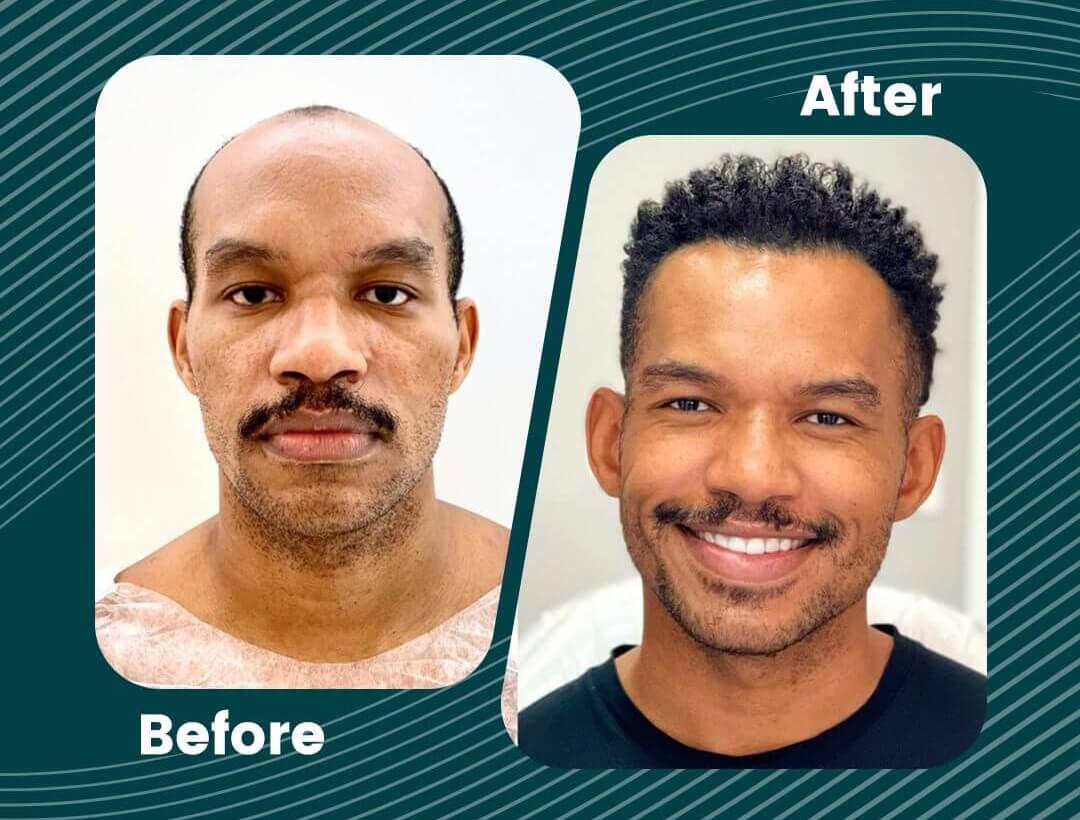
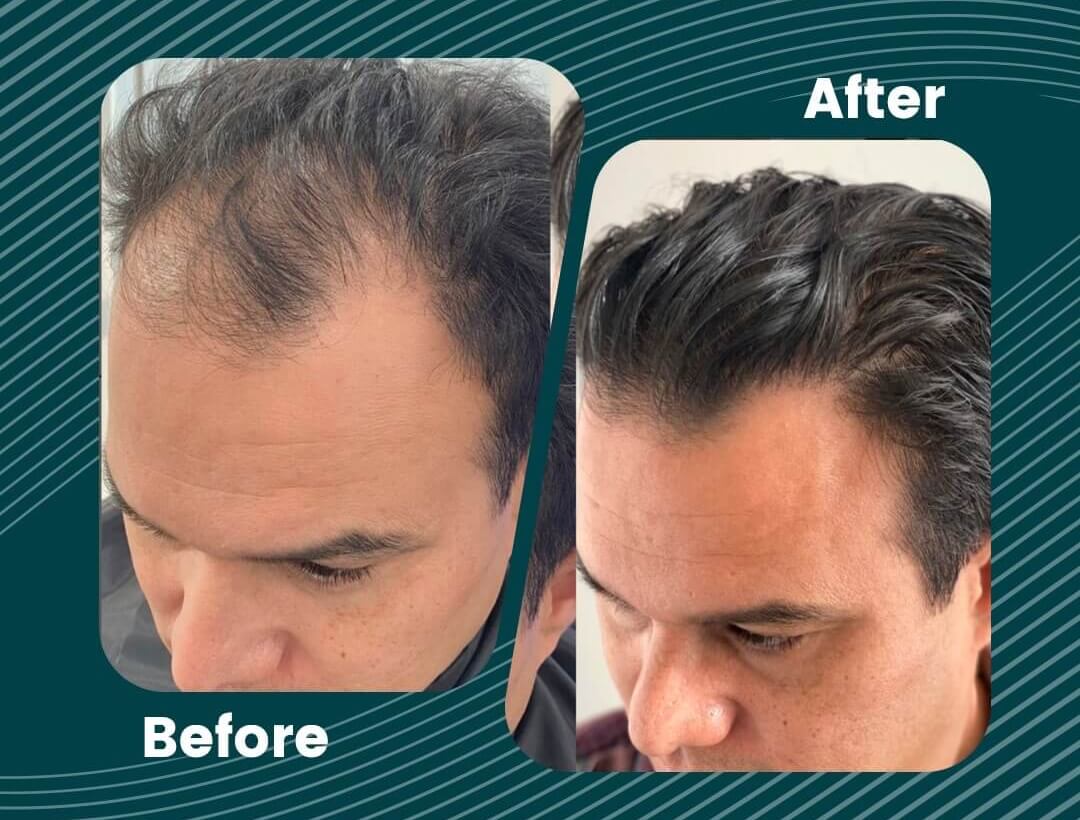
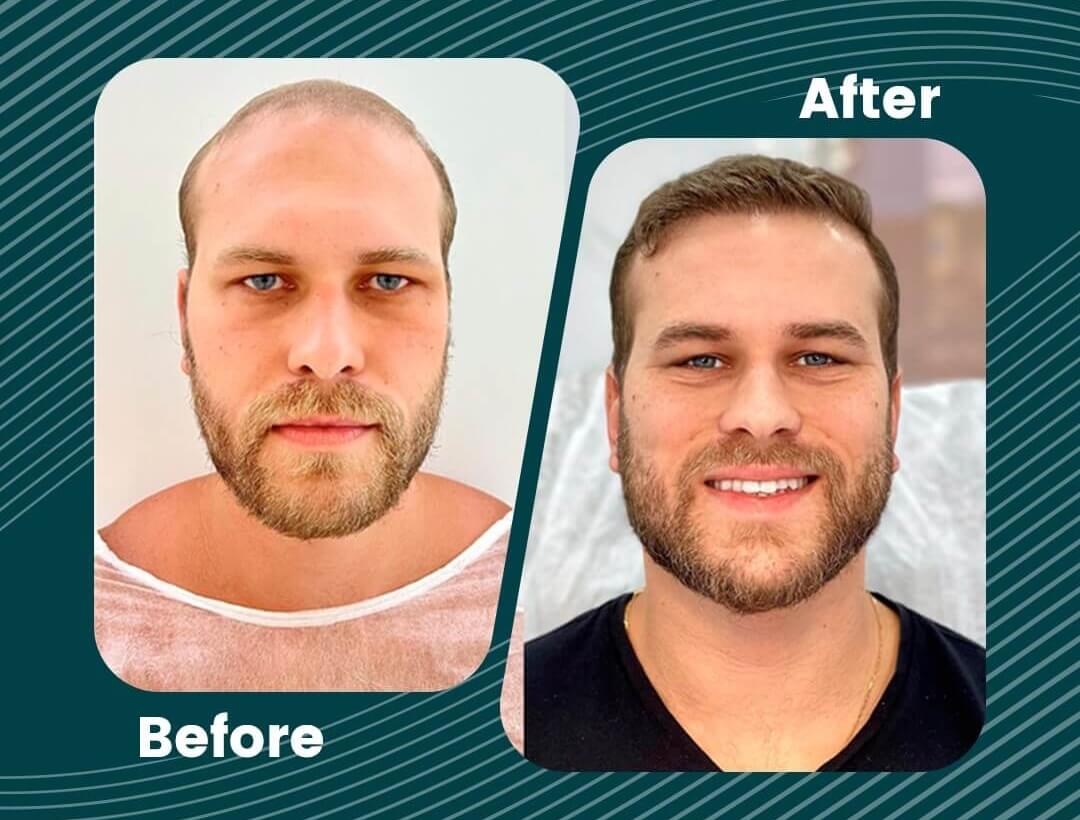
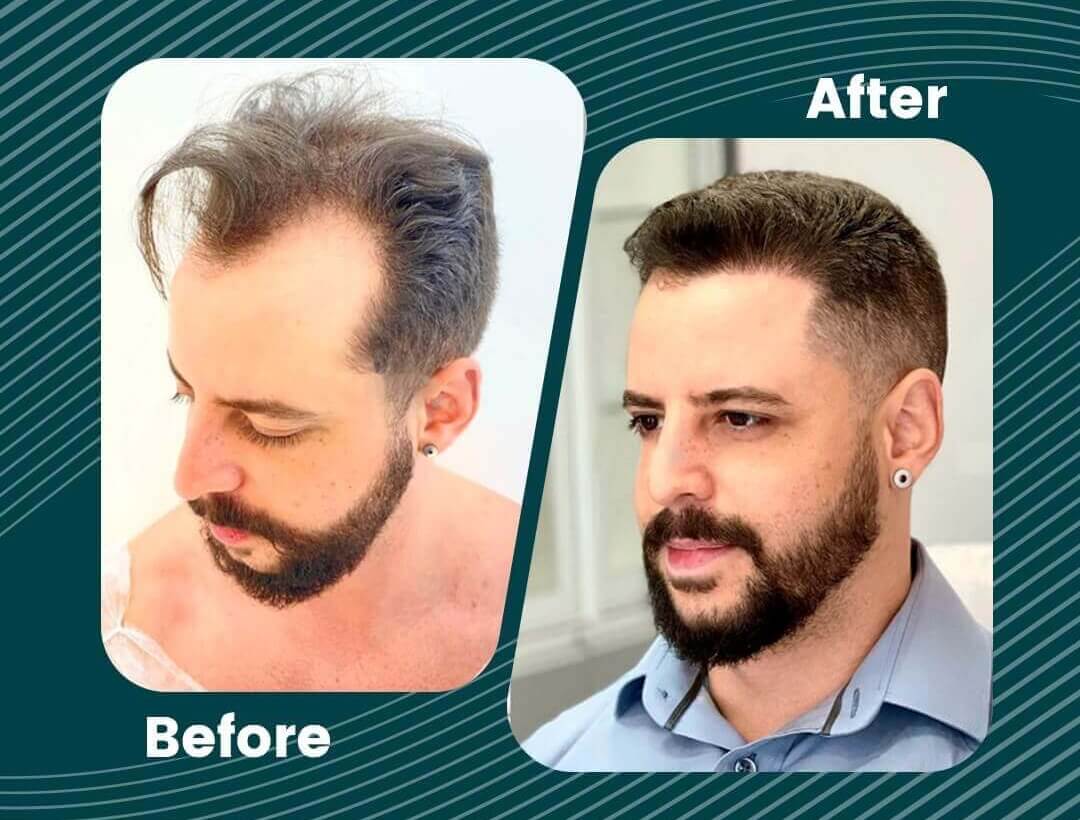
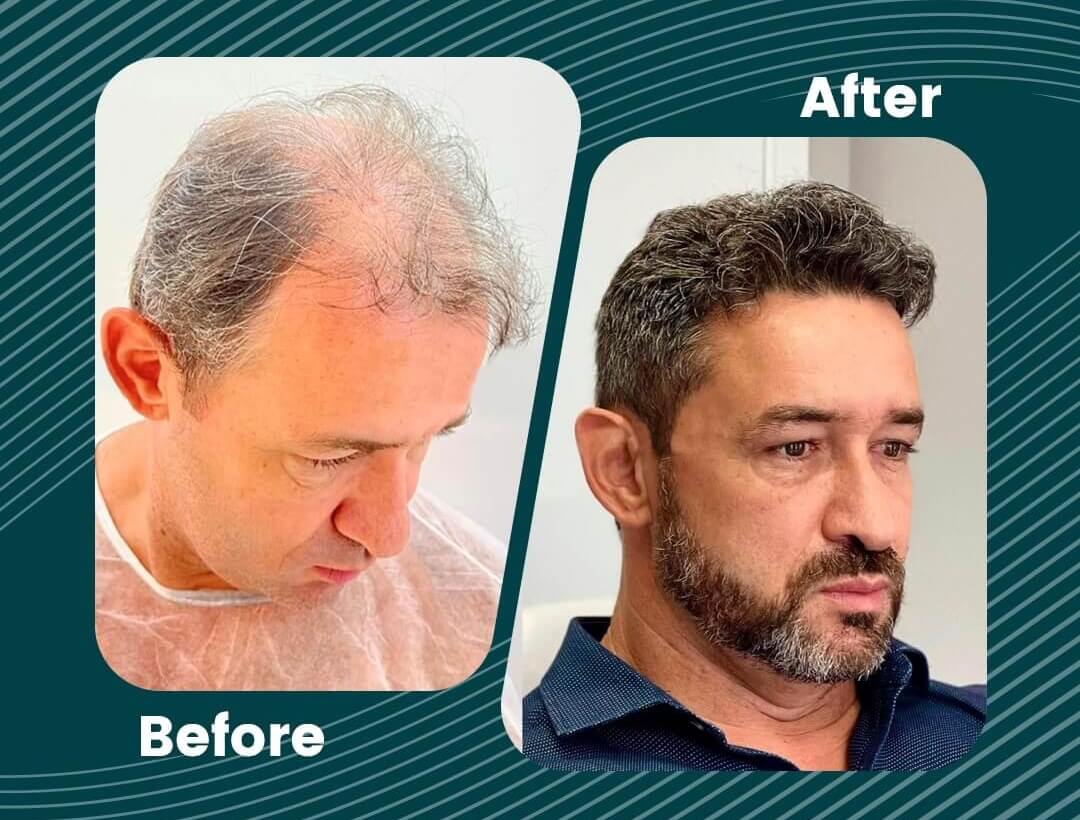
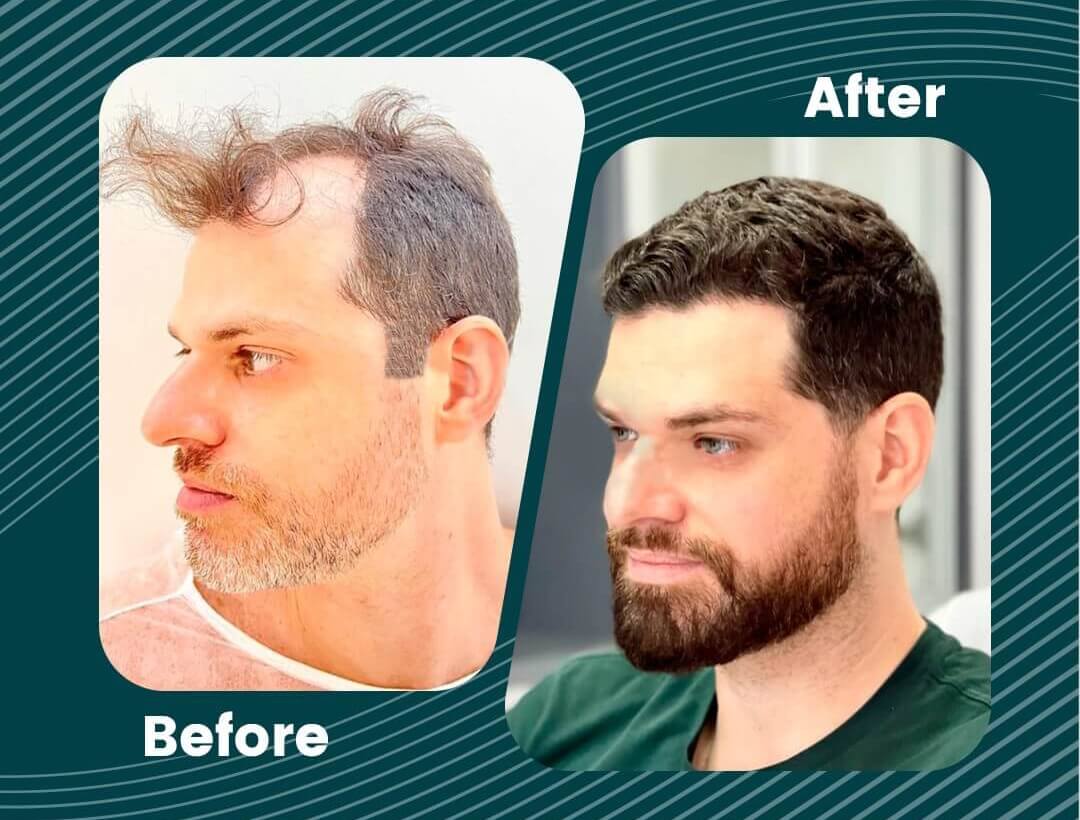
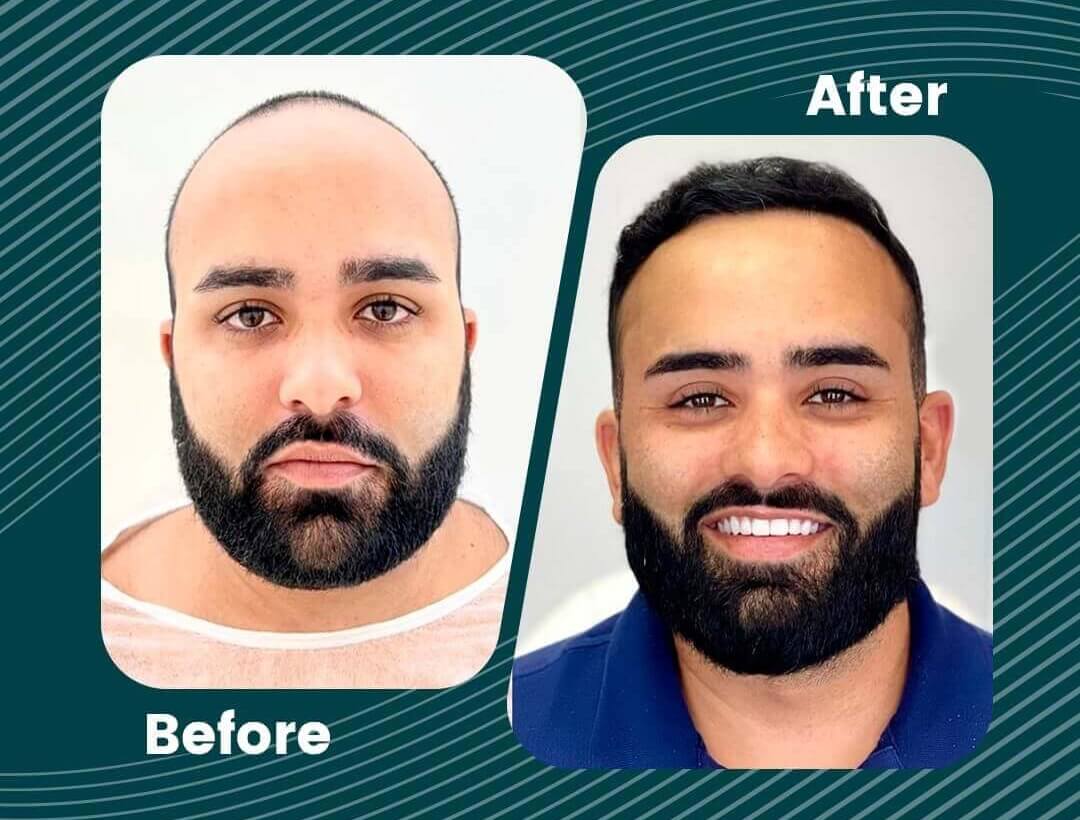
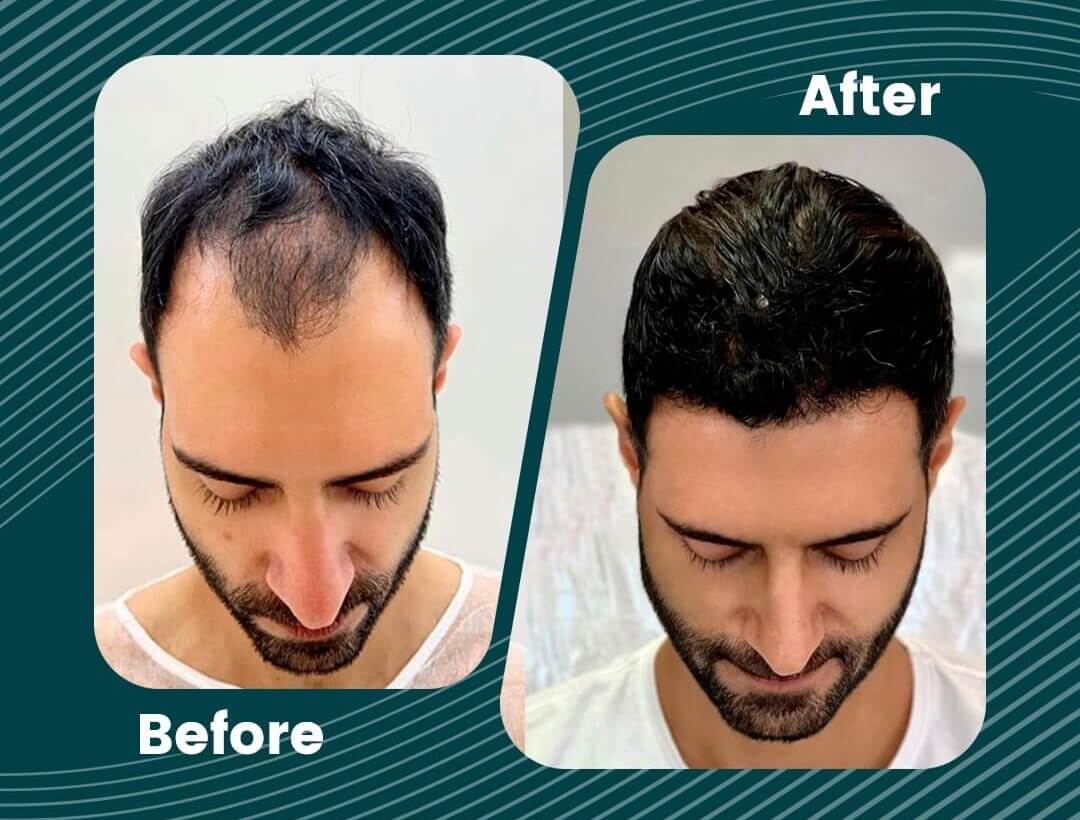
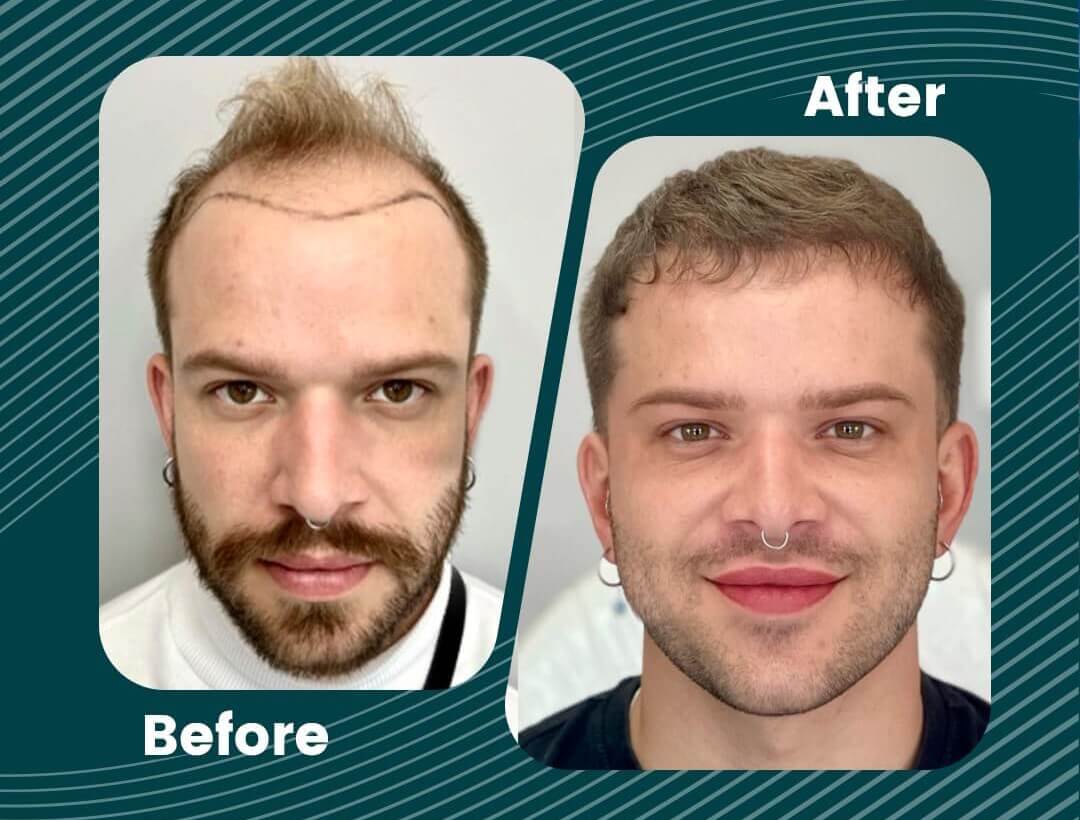
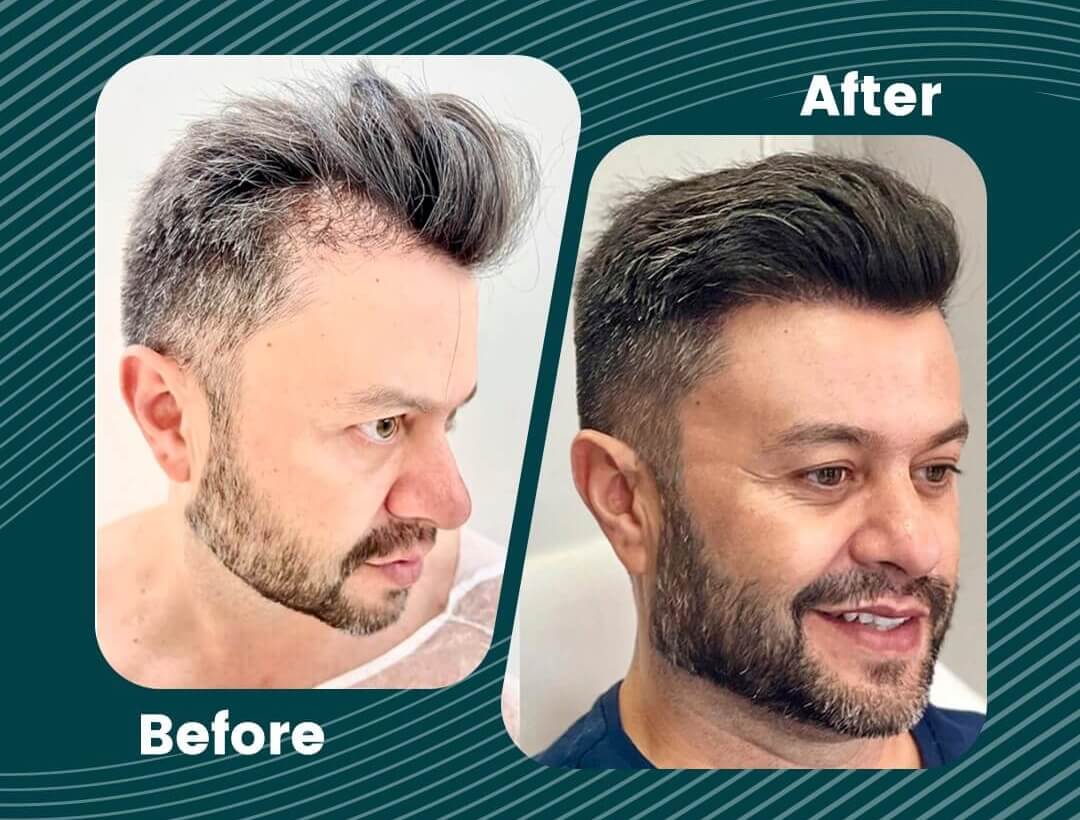

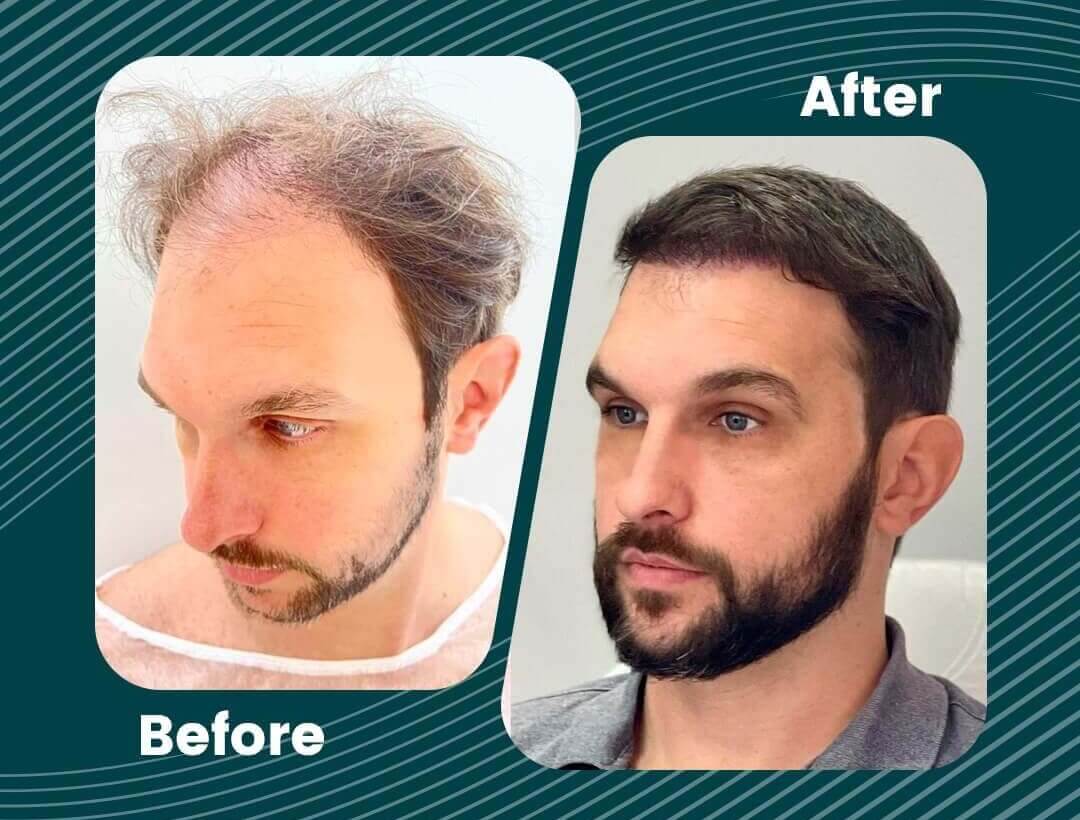
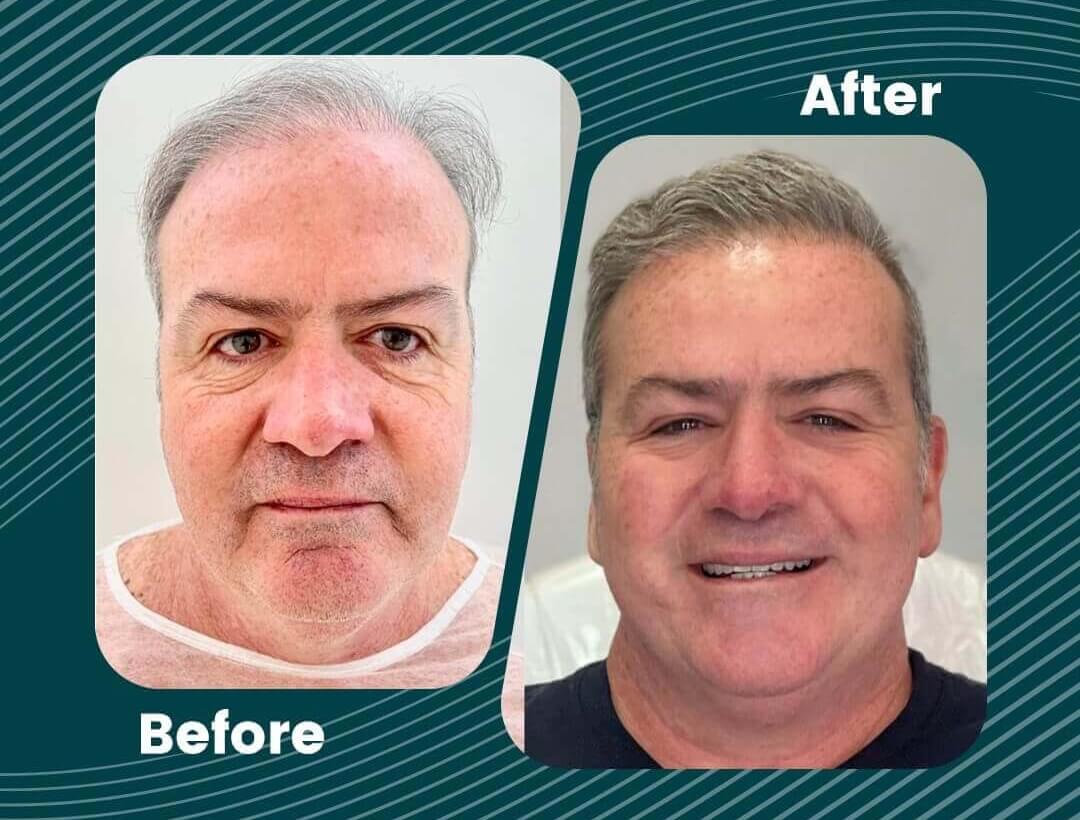
Hair transplantation offers permanent solutions to combat hair loss and baldness.
Check out the quality and service of our clinic by looking at the before and after photos of our patients who had hair transplants at EstheMed Clinic and see their amazing results.
Thanks to the advanced hair transplant techniques we use at EstheMed Clinic, we eliminate all concerns of our patients such as scars and focus on achieving the most natural-looking results.
We provide world-class hair transplantation services to hundreds of patients every year. Please contact us for your own hair transplant transformation.
Why Choose Hair Transplant in Turkey?
Turkey has become synonymous with world-class hair transplant services, attracting thousands of patients every year.
- Experienced Surgeons: Some of the best hair transplant surgeons in Turkey are internationally recognized for their expertise.
- Advanced Techniques: Clinics offer cutting-edge methods like FUE (Follicular Unit Extraction) and DHI (Direct Hair Implantation).
- Cost-Effective Treatments: Hair transplantation in Turkey costs significantly less compared to many Western countries, without compromising on quality.
- All-Inclusive Packages: Many clinics provide packages covering hair surgery, accommodation, transportation, and aftercare.
EstheMed Clinic offers the highest standards for hair transplant procedures in Turkey, using FUE, DHI and Sapphire FUE Transplantation techniques in all operations. This reflects our clinic’s commitment to excellence.
At EstheMed Clinic, we specialize in providing the highest standards of hair transplant procedures in Turkey. Our commitment to excellence ensures that each patient receives personalized care and the latest advancements in hair restoration technology.
Benefits of Hair Transplant in Turkey
- Expertise: Turkish hair surgeons are among the best globally, ensuring high-quality results.
- Affordability: Treatments like hair operation Turkey are accessible without compromising on quality.
- Comprehensive Packages: Includes everything from the procedure to post-surgery care.
EstheMed's Key Priorities
At EstheMed Clinic, there are three core priorities: aesthetic excellence, patient comfort, and long-term transformation. First, achieving a highly natural-looking result is a major goal in every operation. Secondly, the clinic ensures the patient’s utmost comfort during and after the procedure through various measures. Finally, EstheMed closely monitors the patient’s transformation over time, offering a comprehensive approach to hair transplants in Turkey. For EstheMed, the experience goes beyond just a medical procedure—it’s about creating a seamless journey that includes exceptional hospitality, the surgery itself, and a life-changing outcome for the patient.
Turkey is renowned worldwide for offering high-quality hair transplant procedures at a fraction of the cost compared to other countries. The cost of a hair transplant in Turkey typically ranges from $2,750 to $5,000, depending on the technique, number of grafts, and clinic reputation. Advanced methods like FUE (Follicular Unit Extraction) and DHI (Direct Hair Implantation) are popular choices, ensuring natural results with minimal downtime.
One of the key reasons Turkey attracts thousands of patients annually is the availability of all-inclusive packages. These often cover the hair transplant operation cost, accommodation in luxury hotels, airport transfers, and post-operative care, making the process convenient and cost-effective. By combining affordability with cutting-edge techniques and highly skilled surgeons, Turkey has solidified its position as the go-to destination for hair restoration.
Best Turkey Hair Transplant Package Price
At EstheMed Clinic, we offer a range of comprehensive hair transplant packages designed to meet the diverse needs of our patients. Each package combines cutting-edge techniques with exceptional services to ensure a comfortable and effective hair restoration journey.
- Silver Package: Ideal for those seeking a cost-effective solution without compromising on quality. This package includes maximum grafts, FUE operation, pre-operative blood tests, pain-free anesthesia, and essential post-operative care products. Additionally, enjoy a three-night stay in a five-star hotel, VIP transfers, and interpreter support.
- Gold Package: This package builds on the Silver Package with added benefits, including one session of PRP treatment and a three-month vitamin supply. It is designed for patients looking for enhanced post-transplant support while still enjoying luxury accommodations and comprehensive care.
- Platinum Package: Our most exclusive offering, the Platinum Package features advanced hair transplantation techniques such as DHI or FUE. Alongside all the benefits of the Gold Package, it includes a four-night stay in a five-star hotel, six months of vitamin supply, mesotherapy, and IV vitamin therapy for optimal recovery.
All packages are tailored to ensure the best possible results while maintaining international standards of care. Experience a seamless process from the initial consultation to post-operative care with EstheMed Clinic.
Choose the package that best suits your needs and embark on your journey to achieve the hair of your dreams in Turkey!
- Maximum Grafts
- FUE Operation (Surgical Incisions, Natural Hairline Design, Initial Briefing, Consultation, Planning)
- Hair Transplantation with DHI or SAPPHIRE FUE Technique
- Pre-Op Blood Tests
- Pain-Free Anesthesia
- Medications Used After the Operation (Painkillers, antibiotics etc.)
- Post-Op essential products (washing set, foam, gel, shampoo and lotion)
- Special items to use after hair transplant (like; neck pillow, hat, etc.)
- Medical Examinations Needed Before the Operation
- Accommodation in a 5 Star Hotel for 3 Nights (Including breakfast & Companion's hotel fee is not included.)
- VIP Transfer (Airport - Hotel - Hospital)
- Interpreter Support
- 1 session of PRP
- 3 months of vitamin supply
- Mesotherapy
- IV vitamin therapy (delivers hydration, vitamins, electrolytes, and minerals)
- Maximum Grafts
- FUE Operation (Surgical Incisions, Natural Hairline Design, Initial Briefing, Consultation, Planning)
- Hair Transplantation with DHI or SAPPHIRE FUE Technique
- Pre-Op Blood Tests
- Pain-Free Anesthesia
- Medications Used After the Operation (Painkillers, antibiotics etc.)
- Post-Op essential products (washing set, foam, gel, shampoo and lotion)
- Special items to use after hair transplant (like; neck pillow, hat, etc.)
- Medical Examinations Needed Before the Operation
- Accommodation in a 5 Star Hotel for 3 Nights (Including breakfast & Companion's hotel fee is not included.)
- VIP Transfer (Airport - Hotel - Hospital)
- Interpreter Support
- 1 session of PRP
- 3 months of vitamin supply
- Mesotherapy
- IV vitamin therapy (delivers hydration, vitamins, electrolytes, and minerals)
- Maximum Grafts
- FUE Operation (Surgical Incisions, Natural Hairline Design, Initial Briefing, Consultation, Planning)
- Hair Transplantation with DHI or SAPPHIRE FUE Technique
- Pre-Op Blood Tests
- Pain-Free Anesthesia
- Medications Used After the Operation (Painkillers, antibiotics etc.)
- Post-Op essential products (washing set, foam, gel, shampoo and lotion)
- Special items to use after hair transplant (like; neck pillow, hat, etc.)
- Medical Examinations Needed Before the Operation
- Accommodation in a 5 Star Hotel for 4 Nights (Including breakfast & Companion's hotel fee is not included.)
- VIP Transfer (Airport - Hotel - Hospital)
- Interpreter Support
- 1 session of PRP
- 6 months of vitamin supply
- Mesotherapy
- IV vitamin therapy (delivers hydration, vitamins, electrolytes, and minerals)
Contact us today for a free consultation and discover the highest quality hair transplant services in Turkey.
Hair Loss: Understanding the Basics
What is “hair loss”?
Hair loss refers to the thinning or shedding of hair from the scalp or other parts of the body. It can occur gradually or suddenly, and the severity ranges from mild thinning to complete baldness. Hair loss can affect anyone, regardless of gender or age, though patterns and causes may differ.
Common types of hair loss
- Male Pattern Baldness (Androgenetic Alopecia): A hereditary condition causing a receding hairline and thinning at the crown in men.
- Female Pattern Hair Loss (FPHL): Characterized by overall thinning, especially at the crown, without a receding hairline.
- Alopecia Areata: An autoimmune disorder leading to patchy hair loss.
- Telogen Effluvium: Stress, illness, or hormonal changes can cause temporary shedding.
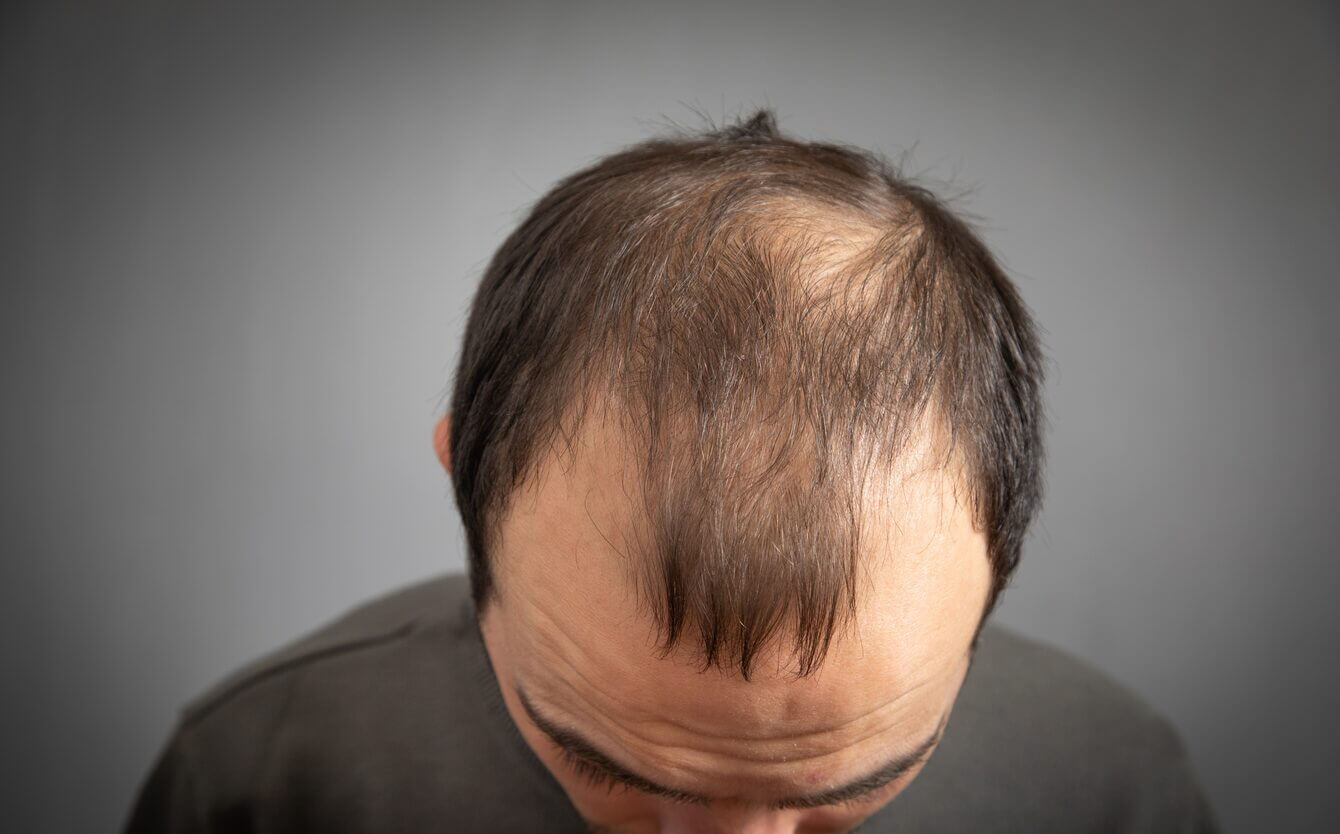
Causes of Hair Loss
Main Causes of Hair Loss in Men and Women
- Genetics: The leading cause of androgenic hair loss in men and women.
- Hormonal Changes: Pregnancy, menopause, and thyroid imbalances can lead to hair loss in women.
- Lifestyle Factors: Poor diet, smoking, and stress contribute to hair thinning.
- Medical Conditions: Conditions like alopecia areata, scalp infections, and diabetes.
Androgenic Hair Loss: What Is It?
Dihydrotestosterone (DHT) sensitivity causes androgenic hair loss, also known as androgenetic alopecia, a hereditary condition. It leads to gradual hair miniaturization and eventual baldness.
Causes of Balding
Balding occurs due to factors like hormonal imbalances, genetic predisposition, aging, and health conditions that impact hair follicle health.
Female hair loss: causes and reasons
- Hormonal shifts during pregnancy or menopause.
- Iron deficiency or other nutritional gaps.
- Overstyling or heat damage from hair products.
- Chronic stress or traumatic events.
Male Pattern Baldness and Female Pattern Baldness
What is male-pattern baldness?
Male Pattern Baldness (MPB) is a progressive hair thinning condition that starts with a receding hairline and thinning at the crown. Genetic sensitivity to DHT is the primary cause.
What Is Female Pattern Hair Loss (FPHL)?
FPHL is a form of hair loss that causes diffuse thinning on the scalp, particularly at the crown. Unlike MPB, it doesn’t lead to complete baldness but significantly reduces hair density.
How to Identify Male and Female Baldness
- Men: Receding hairline, visible scalp, and thinning crown.
- Women: diffuse, thin, and widen the part line.
Hair Loss Treatments: Options and Effectiveness
Hair Loss Treatment Options
Hair Transplant Surgery: Techniques like FUE and DHI offer permanent and natural-looking solutions by redistributing healthy hair follicles to areas of thinning or balding.
Balding Treatment: Effective Solutions
Hair Transplants: The most effective solution for balding, providing a permanent restoration for areas of hair loss.
Best Hair Loss Treatments for Men and Women
For Men: Hair transplants are the top choice, offering lasting results and a natural appearance.
For Women: Hair restoration through hair transplants is a viable option for addressing specific bald or thinning areas.
Female Baldness Treatment: What Works Best?
Hair Transplantation: We tailor surgical solutions like FUE and DHI to meet women’s specific hair restoration needs, ensuring natural results.
Gender-Specific Hair Loss Treatments
Hair loss treatments for men
Hair Transplants: Techniques like FUE and DHI are highly effective, providing natural, long-lasting results for male-pattern baldness.
Hair Loss in Women: Treatments and Causes
Hair Transplants: For severe hair loss or thinning, surgical hair restoration is a reliable solution tailored to women’s unique needs.
Female Hair Loss Treatment Options
Hair Transplants: Advanced procedures like FUE and DHI address significant hair thinning or balding with precision and natural outcomes.
The best hair loss treatment for females
Hair Transplants: Combining advanced surgical techniques with post-care support ensures optimal results for women experiencing severe hair loss.
Preventative measures and early interventions
Reasons for Hair Loss in Women and Men
- Genetic predisposition.
- Nutritional deficiencies.
- Chronic stress and illness.
Top Hair Loss Treatment: Preventative Approaches
- Maintain a balanced diet rich in vitamins and minerals.
- Avoid harsh hair treatments and over-styling.
- Address medical conditions early to prevent further loss.
Choosing the Right Solution
Hair Solution for Hair Loss
- Severity and type of hair loss.
- Budget and available treatment options.
- Personal preferences and lifestyle.
Hair Treatment for Hair Loss
Consult a dermatologist or hair restoration specialist to explore customized treatment plans.
Best Hair Treatment for Hair Loss:
Combine medical treatments, advanced technologies, and lifestyle adjustments for optimal results.
FAQs about hair loss and treatments
What Are the Main Causes of Hair Loss?
Genetics, hormonal changes, medical conditions, and lifestyle factors all play a significant role.
Can Hair Loss Be Reversed?
Yes, early intervention with medications, lifestyle changes, or surgical solutions can reverse some types of hair loss.
How Effective Is Hair Loss Treatment?
Effectiveness depends on the treatment type and the stage of hair loss. Medical and surgical solutions often yield significant results.
Are Treatments for Male Pattern Baldness Different from Female Pattern Baldness?
Yes, treatments are specific to each gender’s needs due to hormonal differences and the patterns of hair loss.
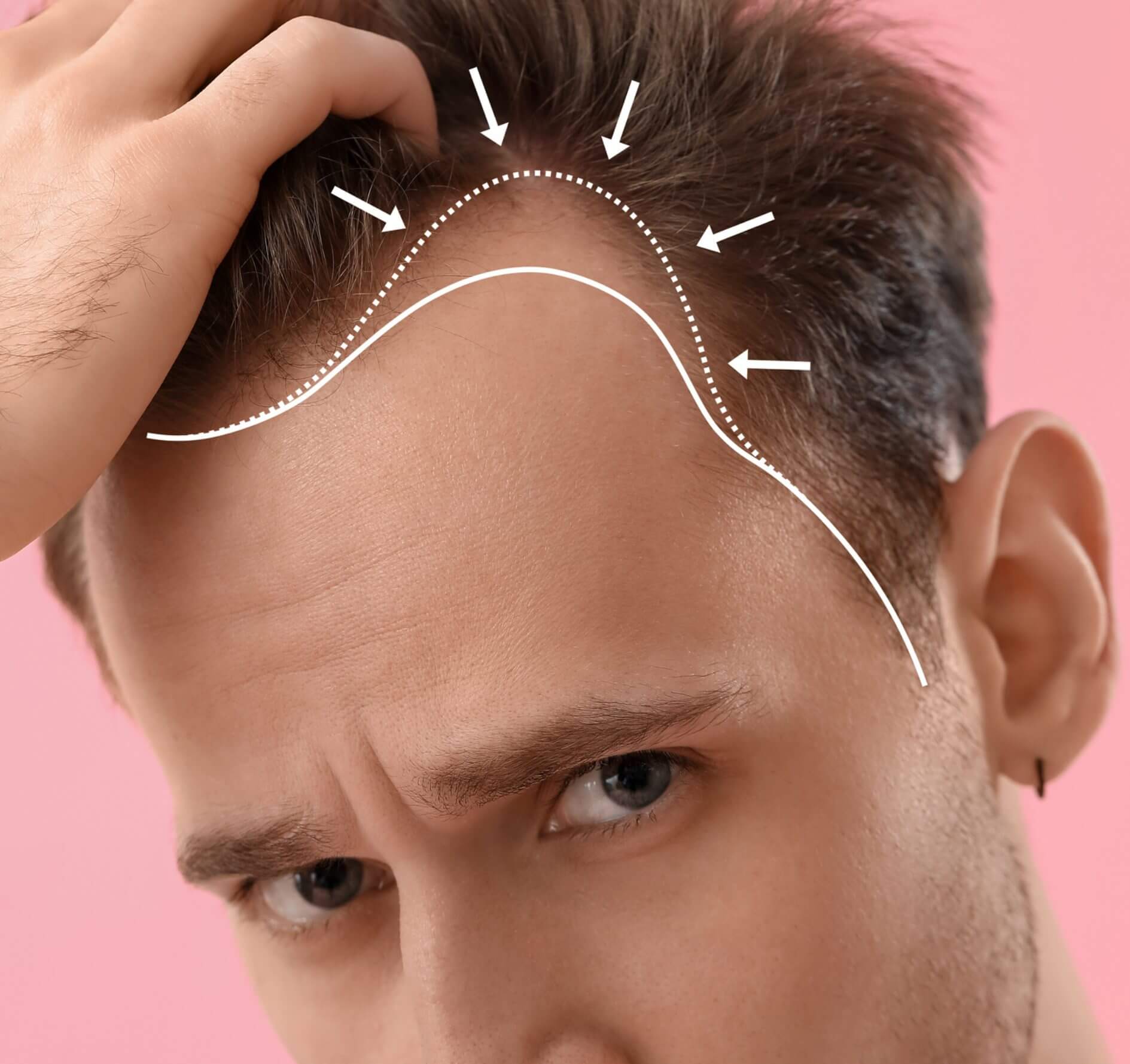
Hairline Loss
Hairline loss and receding hairline are common challenges that affect both men and women. A thinning or receding hairline not only impacts appearance but can also affect self-confidence. Whether it’s due to genetics, aging, or lifestyle factors, there are effective treatments and solutions to restore a natural, fuller hairline.
What Causes Hairline Loss and Receding Hairline?
- Genetics: The most common cause, especially in men, is androgenetic alopecia, leading to hair receding or balding at the temples.
- Aging: Natural aging often results in a gradual thinning of the hairline.
- Hormonal Changes: Fluctuations in hormone levels, particularly in women, can trigger hairline loss.
- Stress and Lifestyle: Poor nutrition, stress, and inadequate hair care can exacerbate hairline thinning.
Hairline Transplant: The Ultimate Solution
A hairline transplant is the most effective way to address significant hairline loss or a receding hairline. Advanced surgical methods such as FUE (Follicular Unit Extraction) and DHI (Direct Hair Implantation) offer natural and long-lasting results.
- FUE Hairline Transplant: This method extracts individual follicles from the donor area and implants them into the receding hairline.
- DHI Hairline Transplant: This technique uses a Choi implanter pen to directly implant hair follicles, ensuring precision and density in the new hairline.
Hairline Transplant Cost
- Hairline transplant cost in Turkey is significantly more affordable compared to other countries, with no compromise on quality.
- Prices vary depending on the number of grafts required, typically ranging from $1,500 to $3,500.
- The hairline grafting cost and hairline implant cost are influenced by the extent of the hairline restoration and the technique used (FUE or DHI).
Hairline Transplants in Turkey
Turkey is a leading destination for hairline transplant surgery, offering:
- Top-rated hairline clinics with experienced surgeons.
- Comprehensive packages, including accommodation and transportation.
- Affordable hairline transplant Turkey cost, making it accessible for international patients.
Hairline Transplant for Women
Women experiencing hairline loss or thinning can benefit from specialized female hairline transplant procedures. These surgeries are tailored to maintain a natural look and restore density to areas affected by hairline thinning.
Before and After Hairline Transplants
The results of a hairline transplant before and after are transformative:
- A fuller, natural-looking hairline that frames the face.
- Improved confidence and aesthetics.
- Long-term hair growth due to the use of healthy, DHT-resistant follicles.
Take the first step toward restoring your confidence with a customized hairline transplant or hairline growth treatment. Turkey offers world-class solutions at competitive costs, ensuring you achieve the look you desire.
Androgenetic Alopecia
What is Androgenetic Baldness?
Androgenetic baldness, also known as androgenetic alopecia, is a common form of hair loss that occurs due to genetic predisposition and hormonal changes. It affects both men and women, though the patterns and progression differ. In men, it’s often referred to as male pattern baldness, while in women, it’s called female pattern hair loss (FPHL).
Signs and Symptoms of Androgenic Hair Loss
- In Men: Hair loss typically begins at the temples and crown, eventually leading to partial or complete baldness.
- In Women: Hair thinning occurs across the scalp, particularly at the parting line, without leading to total baldness.
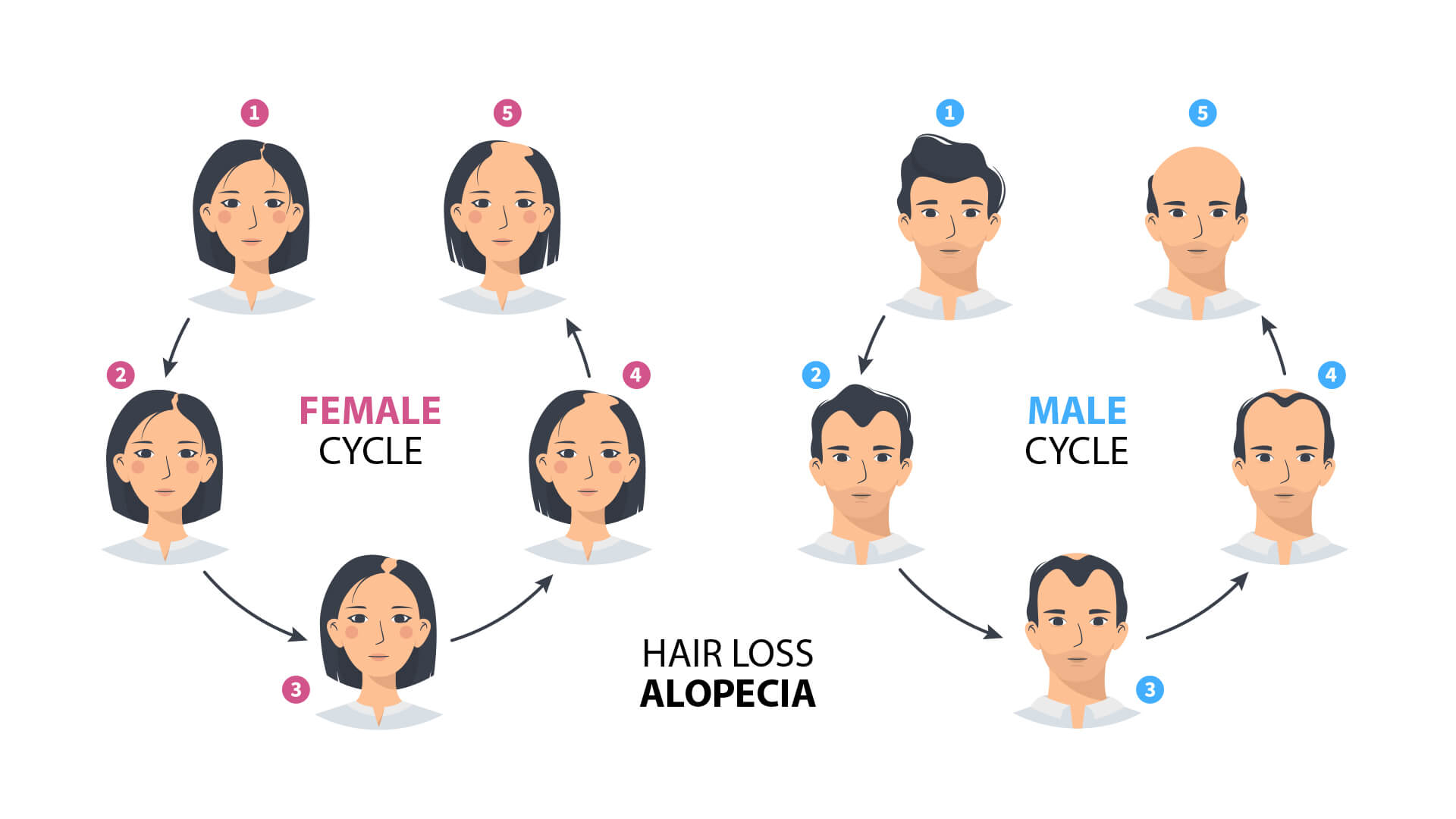
Causes of Androgenetic Alopecia
The Role of Hormones in Androgenic Alopecia
The primary hormone responsible for androgenic hair loss is dihydrotestosterone (DHT), a derivative of testosterone. DHT binds to receptors in hair follicles, causing them to shrink (a process called miniaturization), which leads to shorter hair growth cycles and thinner hair strands.
Genetic Factors in Androgenetic Baldness
Androgenetic alopecia is hereditary. If your family has a history of baldness, you are more likely to experience it. The condition is polygenic, meaning multiple genes inherited from both parents play a role.
Androgenic Alopecia in Females
How Androgenic Alopecia Affects Women
While androgenic hair loss in women is less noticeable than in men, it can still be emotionally distressing. Women rarely experience complete baldness but may notice a gradual widening of their parting and overall scalp thinning.
Diagnosing Female Pattern Baldness
Doctors often use a combination of the Ludwig Scale and a detailed medical history to diagnose androgenic alopecia in women. Blood tests may also be conducted to rule out other causes like nutritional deficiencies or thyroid disorders.
Treatment Options for Androgenetic Alopecia
Hair Transplantation for Androgenetic Baldness
For advanced hair loss, surgical options like FUE (Follicular Unit Extraction) and DHI (Direct Hair Implantation) are effective solutions. These techniques involve extracting hair follicles from donor areas (usually the back of the scalp) and implanting them into thinning or balding areas.
Preventing Androgenetic Baldness
Early Detection and Intervention
Acting early is crucial for managing androgenic alopecia. Regular monitoring of hair density and seeking medical advice when initial signs appear can slow the progression.
Maintaining Hair Health
- Use shampoos and conditioners designed to support scalp health.
- Maintain a balanced diet rich in iron, zinc, and biotin.
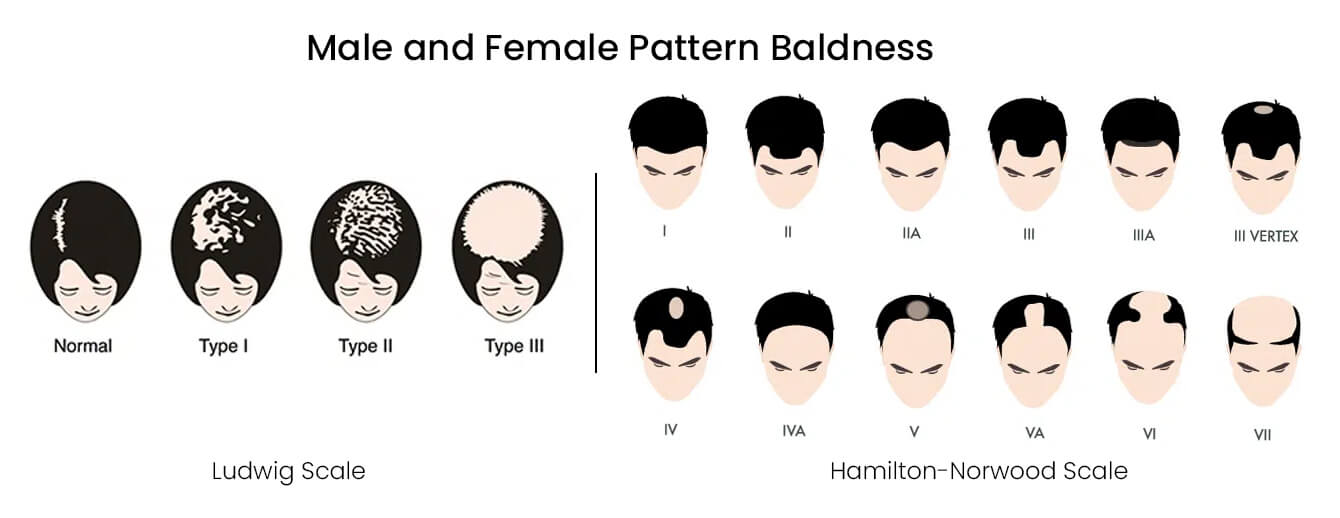
Male and Female Pattern Baldness: Hamilton-Norwood and Ludwig Scales
Hair loss patterns differ significantly between men and women, and specialized classification systems help diagnose, evaluate, and track their progression. The Hamilton-Norwood Scale is widely used for male pattern baldness, while the Ludwig Scale serves as the standard for female pattern hair loss.
Male Pattern Baldness and the Hamilton-Norwood Scale
What is Male Pattern Baldness?
Male pattern baldness (androgenetic alopecia) is the most common type of hair loss in men. It is characterized by a receding hairline and thinning at the crown, eventually leading to complete baldness in some cases.
The Hamilton-Norwood Scale categorizes the progression of male pattern baldness into seven stages:
- Stage 1: Minimal or no hairline recession.
- Stage 2: Slight recession around the temples, forming an M-shaped hairline.
- Stage 3: Deeper temple recession with noticeable hair thinning on the crown.
- Stage 4: Significant thinning or baldness at the crown, with a distinct separation from the frontal hairline.
- Stage 5: The bald areas in the crown and frontal regions become larger and closer together.
- Stage 6: The bald regions merge, leaving hair only on the sides of the scalp.
- Stage 7: Complete baldness, with only a thin band of hair remaining around the sides and back of the head.
Female Pattern Baldness and the Ludwig Scale
What is Female Pattern Baldness?
Female pattern baldness (androgenetic alopecia in women) presents as diffuse thinning of hair across the scalp, particularly at the crown. Women rarely experience complete baldness but may notice a widened part or overall scalp visibility.
The Ludwig Scale classifies female pattern hair loss into three grades:
- Grade I: Mild thinning with minimal widening of the central part.
- Grade II: Moderate thinning, with a noticeable increase in part width and reduced hair volume.
- Grade III: Severe thinning, with widespread hair loss across the scalp but preservation of the frontal hairline.
Hair Transplant: Hair Loss (Baldness) Treatment
Hair transplant procedures are widely regarded as the most effective and permanent solution for hair loss. They offer natural-looking results by redistributing healthy hair follicles to thinning or balding areas of the scalp. Below is a detailed overview of hair transplant options, including specific conditions like receding hairlines, crown balding, and thinning.
Hair Transplant: A Tailored Solution for Hair Loss
FUE (Follicular Unit Extraction):
- Individual hair follicles are harvested from the donor area (usually the back or sides of the scalp) and transplanted to balding areas.
- Minimally invasive technique with minimal scarring.
- Offers natural-looking results and is ideal for those seeking precision in hairline restoration.
DHI (Direct Hair Implantation):
- A more advanced form of FUE where follicles are implanted directly into the scalp using a specialized tool.
- Ensures higher accuracy and density.
- Faster recovery time compared to traditional methods.
Best Hair Transplant Options for Men and Women
Men
- Hair transplant techniques like FUE and DHI are ideal for male pattern baldness.
- These procedures effectively restore hairlines, crown areas, and thinning spots.
Women
- Hair transplants are an excellent solution for women with significant thinning or bald patches.
- Customized approaches ensure natural results that blend seamlessly with existing hair.
Hair Transplant for Female Baldness
Female pattern hair loss often involves diffuse thinning rather than complete bald spots. Hair transplants are an effective solution for:
- Rebuilding Density:
Transplants focus on improving hair volume in thinning areas. - Natural Results:
The procedure is customized to match the natural direction and flow of existing hair. - Permanent Solution:
Unlike temporary treatments, transplanted hair grows naturally and requires no special maintenance.
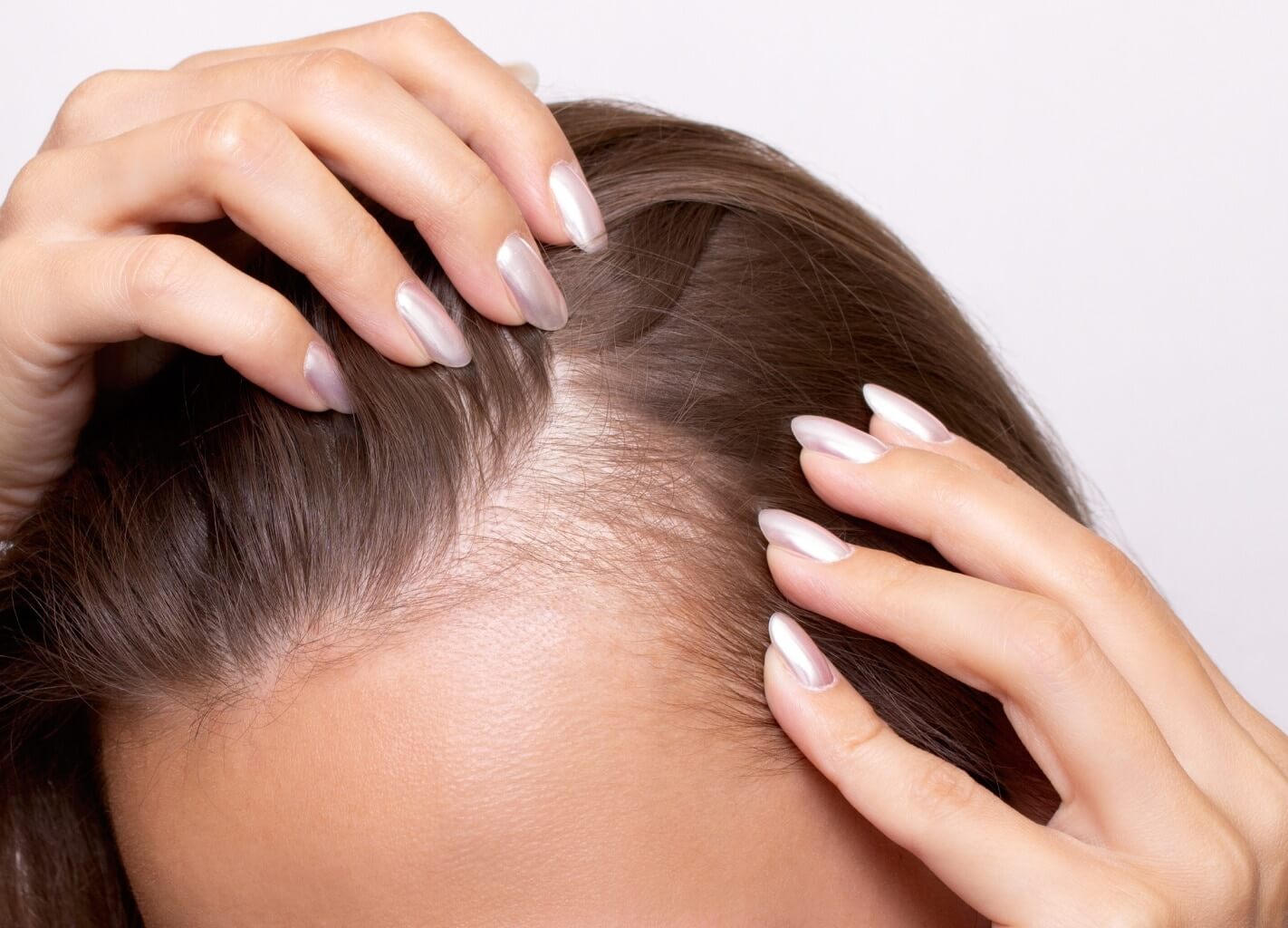
Hair Loss and Hair Thinning
Hair loss and hair thinning are common concerns for both men and women, affecting confidence and overall appearance. While hair thinning may be subtle initially, if left untreated, it can progress to significant hair loss or even balding. This guide explores the causes, treatments, and remedies for these conditions, tailored to both men and women.
Reasons for Hair Thinning and Hair Loss
- Genetic Factors: Conditions like male pattern hair loss and women’s hair thinning are often hereditary.
- Hormonal Changes: Menopause, pregnancy, or hormonal imbalances can cause women’s hair thinning, while DHT (dihydrotestosterone) impacts men, leading to male pattern hair loss.
- Nutritional Deficiencies: Lack of essential vitamins and minerals weakens hair health.
- Stress and Lifestyle: High stress levels, poor diet, and lack of sleep contribute to thinning hairline and hair weakening.
- Medical Conditions: Thyroid issues, alopecia areata, or scalp infections can lead to hair thinning and hair loss.
Hair Thinning and Hair Loss Treatments
Whether you’re dealing with men’s hair thinning or women hair balding, there are numerous options to address the issue:
Medications:
- Minoxidil: FDA-approved for both men and women, it stimulates hair regrowth.
- Finasteride: Specifically for men, it combats DHT-related hair thinning.
Hair Transplant Surgery:
- Advanced techniques like FUE and DHI are ideal for severe hair thinning and hair loss in men and women. These procedures restore volume in areas like the thinning hairline and crown.
PRP Therapy: Platelet-Rich Plasma (PRP) therapy rejuvenates dormant follicles and improves thickness.
Lifestyle Changes and Remedies:
- Balanced Diet: Nutrients like biotin, zinc, and iron are essential for healthy hair.
- Stress Management: Practices like yoga or meditation can reduce hair fall.
Specialized Products for Hair Thinning Treatment:
- Hair serums and shampoos designed for hair thinning women treatment and male hair thinning treatment can improve density and strength.
Gender-Specific Solutions
Men’s Hair Thinning Treatment: Options like finasteride, PRP therapy, and surgical interventions such as male hair transplant surgery are effective in treating male pattern hair loss and men’s hair thinning.
Women’s Hair Thinning Treatment: For women, treatments like minoxidil, hormonal therapy, and lifestyle changes can significantly improve conditions like women hair balding and hair thinning.
Remedies for Hair Thinning and Hair Loss
For those seeking natural solutions, remedies like scalp massages, essential oils, and hair masks can promote blood flow and reduce hair loss and thinning. These remedies are often combined with clinical treatments for optimal results.
Take Action Today
If you’re experiencing hair loss or hair thinning, don’t wait for it to worsen. Explore treatments like hair thinning women treatment, male pattern hair loss treatment, or surgical solutions to restore your confidence and achieve thicker, healthier hair.
Airport Transfer
Transfer service with our superior vehicle comfort, our experienced chauffeurs.
Medications
Medications are required during, before and after hair transplantation surgery.
Accommodation
Best all inclusive hotels in Turkey - 4 or 5 - star hotels accommodation.
Aftercare Services
We provide post-transplant care instructions and a help so you get all the guidance you need.
Translators
Our professional translators will be with you from the moment you arrive in Turkey until you return.
Online Consultation
Get instant results with online consulting. Plus it’s Free!
Hair Transplant for Women
At EstheMed, we understand that hair loss is not just a concern for men; it affects women as well. That’s why we are dedicated to providing tailored hair transplant solutions specifically designed to meet the unique needs of women experiencing hair thinning or loss.
Hair transplantation for women has come a long way in recent years, offering a viable solution for many individuals struggling with hair loss. As techniques continue to improve and our understanding of female hair loss deepens, we can expect even better outcomes and more personalized treatment options in the future.
For women considering hair transplantation, it’s crucial to approach the decision with realistic expectations and a thorough understanding of the process. Consulting with a qualified surgeon who specializes in female hair restoration can provide valuable insights and help determine if this procedure is the right choice for your individual needs.
Remember that hair transplantation is just one of many options available for addressing female hair loss. A comprehensive approach that may include medical treatments, lifestyle changes, and surgical interventions often yields the best results. By staying informed about the latest advancements and working closely with healthcare professionals, women can find effective solutions to restore their hair and boost their confidence.
Female Hair Transplantation
Hair transplantation for women has evolved significantly over the years, becoming a viable and effective solution for many individuals experiencing hair loss. The science behind this procedure is rooted in the concept of hair follicle redistribution, which involves moving healthy hair follicles from areas of dense growth to areas of thinning or baldness.
The process begins with a thorough evaluation of the patient’s scalp and hair loss pattern. This assessment helps determine the viability of the donor area, which is typically located at the back and sides of the head where hair growth tends to be more resistant to hormonal changes. The quality and quantity of available donor hair play a crucial role in the success of the transplant.
The science of hair transplantation also involves careful consideration of the angle, direction, and density of the transplanted hair to ensure a natural-looking result. Surgeons must take into account the patient’s facial features, existing hair patterns, and future hair loss progression when designing the transplant plan.
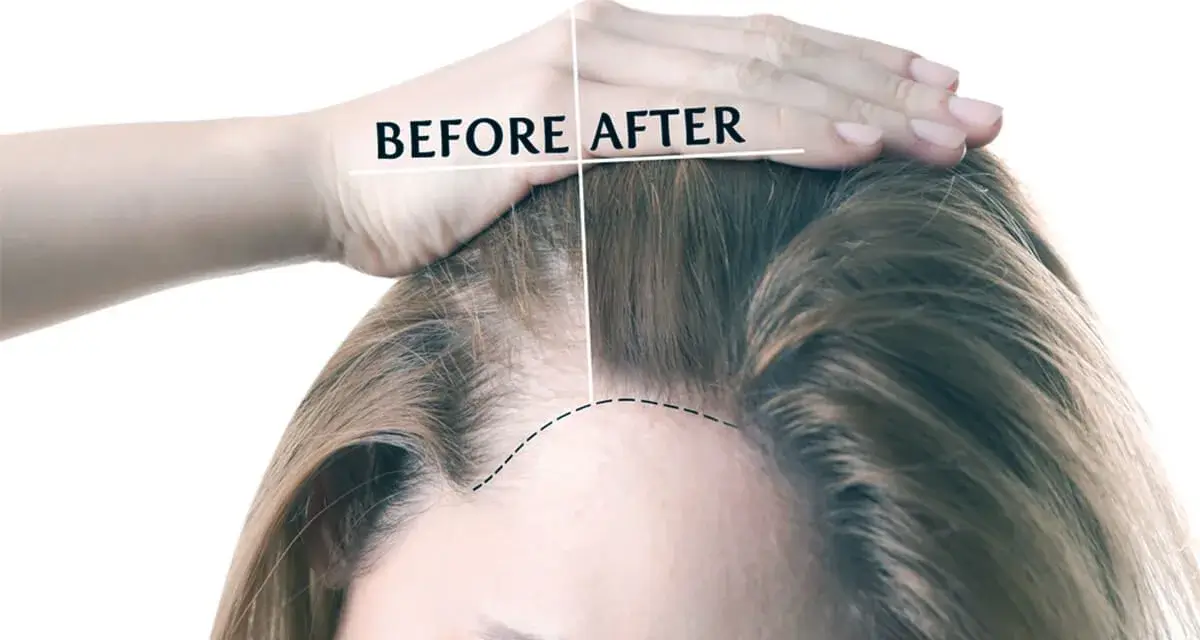
Hair Transplant for Men
Hair loss is a common concern for men, often leading to issues such as male pattern baldness, crown balding, and a receding hairline. With advancements in medical technology, solutions like male hair transplant surgery have become effective, permanent options for restoring confidence and a fuller head of hair.
Understanding Male Hair Loss
Male hair loss typically stems from male pattern baldness, also known as androgenetic alopecia. This condition results in progressive hair thinning, starting with a receding hairline or hair baldness in men, and can lead to complete baldness over time. Other factors like stress, hormonal imbalances, or aging may also contribute to men’s hair thinning and balding.
What is a Male Hair Transplant?
A male hair transplant is a surgical procedure designed to address men’s hair loss, including crown balding, receding hairlines, and thinning in other areas. Common techniques include:
- FUE (Follicular Unit Extraction): Individual hair follicles are extracted from a donor area (usually the back of the head) and implanted into thinning or balding areas.
- DHI (Direct Hair Implantation): Similar to FUE but with a more precise implantation process using a specialized tool for direct placement of follicles.
Why Choose Hair Transplant Surgery?
Unlike temporary solutions like medications or topical treatments, male hair loss surgery offers:
- Permanent Results: Transplanted hair follicles are resistant to DHT, the hormone responsible for hair loss.
- Natural Appearance: Advanced techniques ensure seamless blending with existing hair.
- Versatility: Addresses various patterns of hair loss, including men’s hair receding hairlines and thinning at the crown.
Ideal Candidates for Men’s Hair Surgery
Men experiencing male pattern hair loss or those with localized balding, such as at the crown or along the hairline, are excellent candidates for:
- Hair implants for men
- Hair transplants for men
This procedure is also suitable for men looking to correct severe baldness or improve areas of men’s hair thinning.
Benefits of Male Hair Transplants in Turkey
Turkey has become a global hub for male hair implant surgery, offering:
- Affordable Prices: Competitive costs compared to other countries without compromising quality.
- Experienced Surgeons: Specialists with expertise in male hair surgery and advanced techniques.
- Comprehensive Packages: Many clinics provide all-inclusive services, including accommodation and transportation.
Results: Before and After
The transformation after a male hair transplant is often dramatic, with patients regaining a full, natural-looking head of hair. Restoring the receding hairline, filling in the crown, and addressing men’s baldness significantly improves confidence and appearance.
Take the First Step
If you’re struggling with men’s hair loss, whether it’s male pattern baldness, a crown balding, or a receding hairline, a male hair transplant surgery could be the ideal solution. Schedule a consultation today and discover how you can achieve long-lasting, natural-looking results.
Afro Hair Transplant Turkey
At EstheMed, we are dedicated to providing exceptional hair restoration solutions tailored to diverse hair types, including afro-textured hair. Our specialized afro hair transplant service is designed to help individuals achieve a full and healthy head of hair, restoring confidence and enhancing appearance.
Afro-textured hair possesses distinct qualities that set it apart from other hair types. Its tightly coiled structure and unique growth pattern contribute to its voluminous appearance and versatility in styling. However, these same characteristics can pose challenges when it comes to hair restoration procedures.
The curl pattern of Afro hair extends below the scalp surface, creating a curved follicular structure. This curvature makes the extraction and transplantation process more complex compared to straight or wavy hair types. Additionally, Afro hair tends to have a lower density of individual strands per square inch, though its coiled nature often creates the illusion of fullness.
Another crucial factor to consider is the increased susceptibility of darker skin tones to keloid scarring. This tendency for excessive scar tissue formation requires special attention during any surgical procedure, including hair transplants.
Understanding these unique attributes is essential for both patients and practitioners when approaching Afro hair restoration. It ensures that the chosen techniques and methods are tailored to address the specific needs of this hair type, maximizing the chances of successful and natural-looking results.

Candidacy for Hair Transplantation
Age and Hair Loss Pattern
The age of the patient and the pattern of hair loss play significant roles in determining candidacy for hair transplantation:
Age: Younger patients (under 25) may be advised to wait before undergoing a transplant, as their hair loss pattern may not yet be fully established. Premature transplantation could lead to unnatural-looking results as hair loss progresses.
Hair Loss Pattern: Understanding the progression of hair loss is crucial. Patients with stable hair loss patterns, typically seen in male or female pattern baldness, are often good candidates. Those with unpredictable or diffuse hair loss may need to explore other options.
Donor Hair Quality and Quantity
The success of a hair transplant largely depends on the availability and quality of donor hair:
Density: Patients with higher hair density in the donor areas (usually the back and sides of the scalp) are typically better candidates, as this allows for more grafts to be harvested.
Hair Characteristics: The texture, color, and curl of the donor hair can impact the final results. Coarse, light-colored, or curly hair often provides better coverage than fine, dark, or straight hair.
Scalp Laxity
The flexibility of the scalp, known as scalp laxity, is particularly important for FUT procedures:
Good Laxity: A scalp with good laxity allows for easier harvesting of the donor strip and better wound closure, resulting in a less noticeable scar.
Poor Laxity: Patients with tight scalps may be better suited for FUE procedures or may require scalp exercises to improve laxity before undergoing FUT
Overall Health and Medical History
The patient’s general health status and medical history are critical considerations:
Chronic Conditions: Certain medical conditions, such as uncontrolled diabetes or autoimmune disorders, may affect healing and graft survival.
Medications: Some medications, particularly blood thinners, may need to be adjusted before surgery.
Smoking: Smoking can negatively impact graft survival and healing. Patients may be advised to quit smoking before and after the procedure.
Expectations and Psychological Factors
Realistic expectations and a stable psychological state are essential for patient satisfaction:
Realistic Goals: Candidates should understand the limitations of hair transplantation and have realistic expectations about the results.
Psychological Readiness: Patients should be emotionally prepared for the transplant process and the gradual nature of hair growth post-procedure.
Special Considerations
Certain groups may require additional evaluation:
Women: Female hair loss patterns can be more diffuse, making transplantation challenging. Thorough evaluation is necessary to determine suitability.
Individuals with Scarring Alopecia: Those with hair loss due to injury or previous surgeries may be candidates, but the cause and stability of the scarring need to be assessed.
Ethnic Considerations: Different ethnic groups may have varying hair characteristics and loss patterns, which need to be taken into account.
Determining candidacy for hair transplantation is a complex process that requires careful evaluation by a qualified hair restoration specialist. A comprehensive assessment, including a detailed medical history, scalp examination, and discussion of expectations, is essential to ensure that hair transplantation is the right choice for each individual.
Preparing for a Hair Transplant
Proper preparation is key to ensuring a successful hair transplant procedure and optimal results. The preparation phase typically begins several weeks before the scheduled surgery and involves a series of steps designed to optimize your health, minimize risks, and set realistic expectations for the outcome.
Initial Consultation and Planning
The preparation process starts with a thorough consultation with your chosen hair restoration specialist:
Medical History Review: Provide a comprehensive medical history, including any medications, allergies, and previous surgeries.
Scalp Examination: The surgeon will assess your scalp condition, hair loss pattern, and donor hair availability.
Treatment Plan: Based on the assessment, a personalized treatment plan will be developed, including the number of grafts needed and the chosen technique (FUT or FUE).
Photography: Pre-procedure photos will be taken to document your current hair status and for planning purposes.
Medical Preparations
Several medical considerations need to be addressed in the weeks leading up to the procedure:
Blood Tests: Your surgeon may request blood tests to ensure you’re in good health for the procedure.
Medication Adjustments: Certain medications, particularly blood thinners, may need to be adjusted or temporarily discontinued. Always consult with your primary care physician before making any changes.
Supplements: You may be advised to start taking certain vitamins or supplements to promote healing and hair growth.
Lifestyle Adjustments
Making certain lifestyle changes can significantly improve the outcome of your hair transplant:
Smoking Cessation: If you smoke, you’ll be strongly advised to quit at least two weeks before the procedure, as smoking can negatively impact healing and graft survival.
Alcohol Consumption: Reduce or eliminate alcohol consumption in the week leading up to the hair surgery, as it can increase bleeding during the procedure.
Diet and Hydration: Maintain a healthy, balanced diet and stay well-hydrated in the weeks before the transplant.
Scalp and Hair Care
Proper care of your scalp and existing hair is crucial in the lead-up to the transplant:
Hair Washing: Follow your surgeon’s instructions regarding hair washing in the days before the procedure. You may be advised to use a special shampoo.
Hair Styling: Avoid harsh chemical treatments or hair dyes for at least two weeks before the hair surgery.
Scalp Sunburn: Protect your scalp from sunburn, as this can interfere with the procedure.
Logistical Preparations
Planning the practical aspects of your procedure and recovery is essential:
Time Off Work: Arrange for time off work, typically 3-7 days, depending on the extent of the procedure and your job requirements.
Transportation: Arrange for someone to drive you home after the procedure, as you may be given sedation.
Recovery Space: Prepare a comfortable recovery area at home with all necessary supplies.
Mental and Emotional Preparation
The psychological aspect of preparing for a hair transplant is often overlooked but is crucial for a positive experience:
Realistic Expectations: Understand that results take time to become visible, typically several months.
Support System: Inform close friends or family about your procedure for emotional support during recovery.
Stress Management: Practice stress-reduction techniques, as stress can negatively impact healing and hair growth.
Night Before and Day of Hair Surgery Turkey
The final preparations occur in the 24 hours leading up to the procedure:
Fasting: Follow your surgeon’s instructions regarding eating and drinking before the procedure.
Clothing: Wear comfortable, loose-fitting clothing that doesn’t need to be pulled over your head.
Hair Preparation: Follow any specific instructions for washing or not washing your hair on the day of the procedure.
By thoroughly preparing for your hair transplant, you can significantly improve the likelihood of a smooth procedure and successful outcome. Remember to follow all instructions provided by your hair restoration specialist and don’t hesitate to ask questions if anything is unclear.
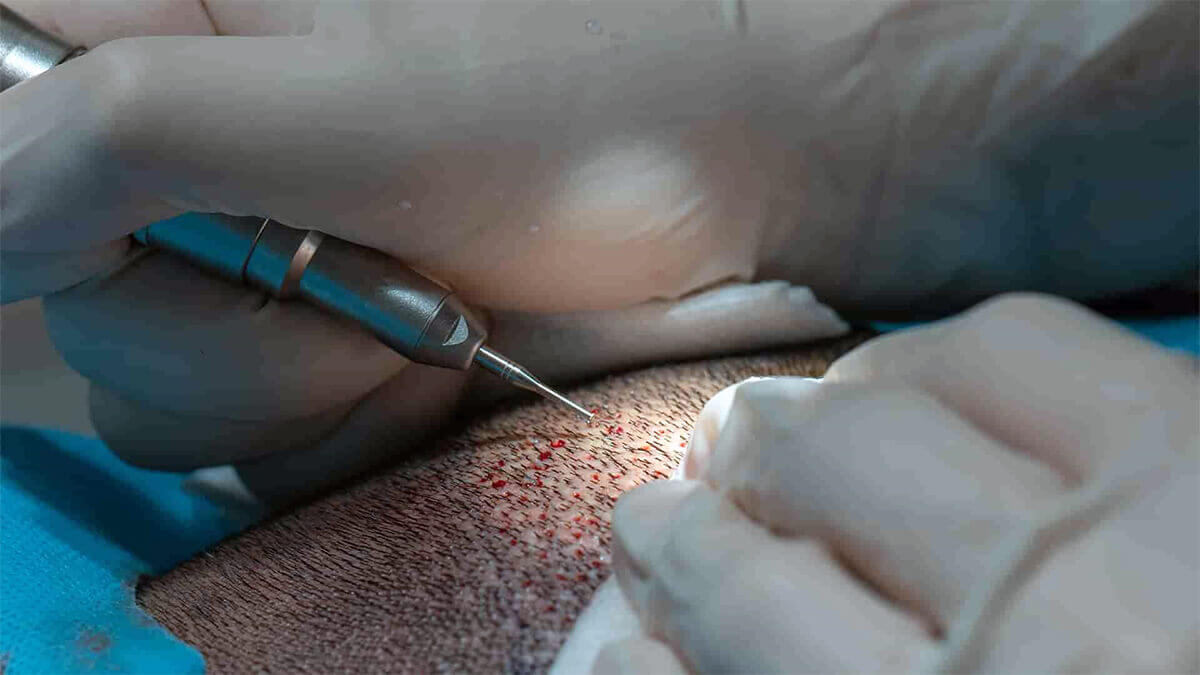
Before Hair Transplant Operation
Another very important factor at this period is the information patients should focus on before to the operation. Usually, patients find great interest in the before and after pictures of hair transplant operations. Learning about the operation and identifying the best clinics specialized in hair transplants is still crucial even if you haven’t decided whether or not to get one yet.
During preoperative treatments, the EstheMed Clinic in Turkey offers the most all-encompassing information. Simultaneously, it covers what you need to know prior to the surgery and all the actions to be conscious of. Speaking with the staff of the clinic and asking all the questions you have can help you learn more before to having a hair transplant.
Things to Consider Before Hair Transplant Operation
Patients should think through some factors before having a hair transplant. Tell your doctor about your daily meds first, before the hair surgery.
Cut off blood-thinning drugs at least one week before the operation. You should simultaneously cease medicines containing vitamins B and E. Better health checks before the operation will follow from telling your doctor especially about a change medicine when you visit the clinic.
You will enable the hair transplant process. You have to indicate whether you are allergic to any of the local anesthetics, tools used in any later parts of the operation, or materials used during the hair surgery. Tell your doctor about your allergic reactions.
Hair transplantation experts advise cutting off drinking one week before the hair surgery. This is so because alcohol could affect local anesthetic.
We also counsel pavers a few days ahead. Stopping smoking for a period is absolutely essential to guarantee a seamless process since smoking damages the blood vessels, which might cause hair follicules.
You can have a small dinner before to entering the clinic for FUE or DHI hair transplant procedures. On the day of the operation, avoid skipping the coffee and breakfast with great nutritious content.
When entering the clinic, you should wear comfortably and quickly remove clothes. Pulling on and off garments is easier with a front zipper or button.
What Should You Consider When Choosing a Hair Transplant Clinic?
Since hair transplantation is a condition requiring surgical intervention, one should be careful and picky while choosing a hair transplant center. You should make sure the hair transplant is done by competent hair transplanters. Furthermore be sure the clinic you select uses sterile surroundings with specialized tools to execute all operations. This will help you to guarantee the clinic follows all the safety precautions before to the hair transplant.
Think about if specialists with necessary knowledge will carry out the operation while choosing the best hair transplanting facility. You also have to visit the clinic, where staff members will walk over the phases of Sapphire FUE, FUE, and DHI hair transplant techniques with you. In this sense, EstheMed Clinic keeps running as the best hair transplant clinic in Turkey, precisely and flawlessly.
Thanks to EstheMed Clinic in Turkey, you can have the natural hair of your desires even if the cost of hair transplantthere is really inexpensive.
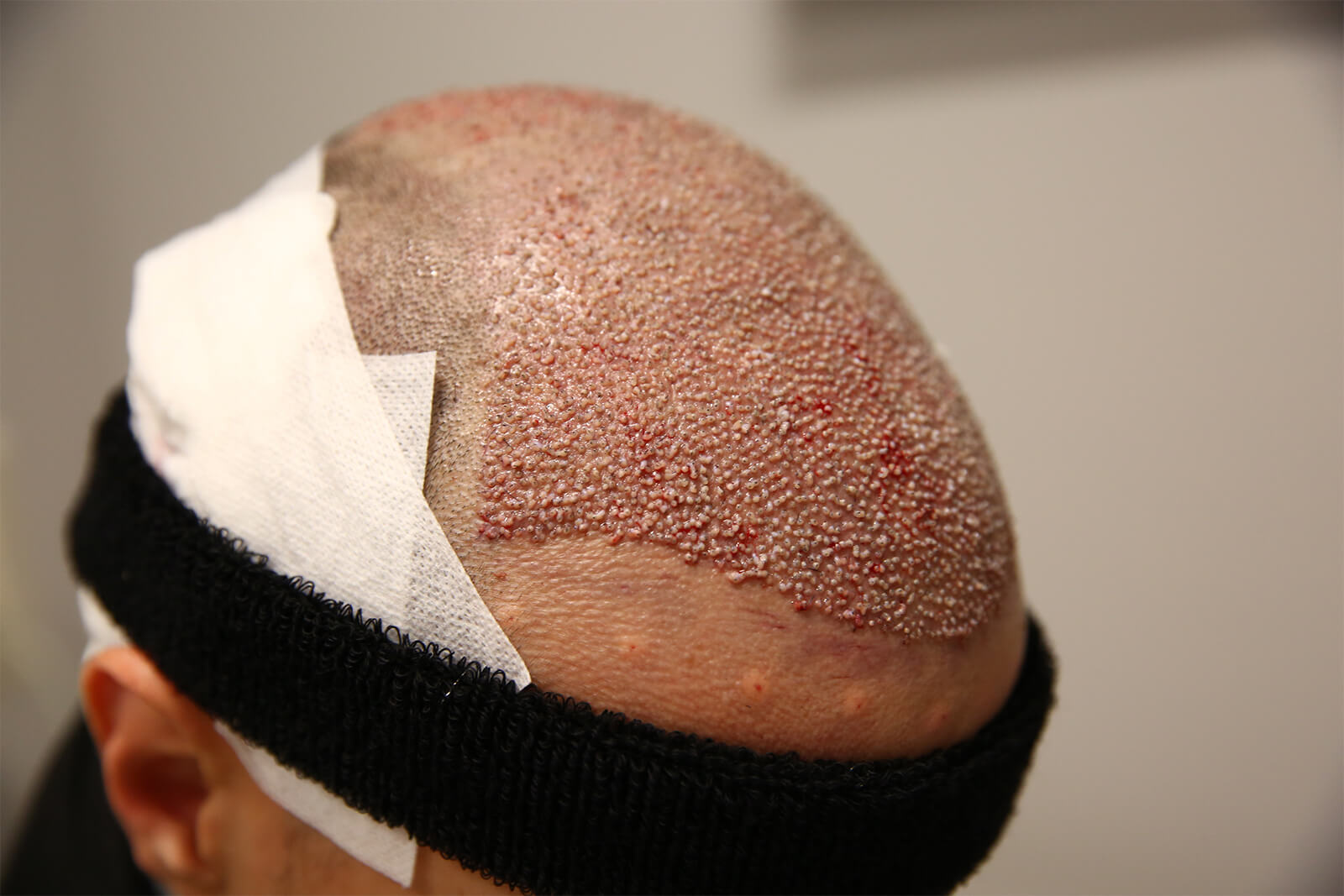
After Hair Transplant Operation
The FUE, Sapphire FUE, or DHI hair transplant surgeries start a particular healing process. Your natural hair might grow back with clear changes over time. Experts in hair restoration advise you to recover fast within this time span.
Still the best hair transplant facility in its field is EstheMed Clinic. Following a normal 7 to 8 hour surgical session, we wrap and attach a hair graft to your scalp. During the healing stage following the operation, we perform the required corrections.
Things to Consider After Hair Transplant
Men and women must consider specific factors following a hair transplant. Following advice from your doctor is absolutely vital for a faster recovery. Therefore, it would be advisable if you paid attention to avoiding striking your head following the hair transplant operation.
The implanted grafts fuse to the scalp generally in one week. A trauma to the head or bad sleeping posture could lead to graft loss during the operation. You should thus pay close attention to sleeping straight forwardly. Simultaneously, you should avoid any head impact and prevent from engaging in intense sports.
It will assist to avoid alcohol, smoking, and big meals both before and following the hair transplant operation. This helps you make sure the scar formations on your scalp diminish quickly and speed your recuperation.
The first week should be spent not doing anything, including any kind of hand massaging of your scalp. Still, you should be careful when sleeping to prevent poor posture and head bumps. EstheMed Clinic also provides professionally created and instructive kits to provide its patients more in-depth knowledge.
Should you wish to go outside in the days following the operation, you can cover the transplanted area with an umbrella. At this period, we advise against donning headgear and other such accessories. Concurrently, getting as much rest as possible following surgery improves recovery.
Before you leave the clinic, you should be sure you know enough about the prescription drugs and specific hair care products the doctor will prescribe you. Hair therapists can help you get information pertinent to all possible situations by means of consultation.
What is the Healing Process of Hair After Hair Transplantation?
EstheMed, the best hair transplant clinic in Turkey, provides its patients with comprehensive justifications of every action taken during a hair transplant. The healing process starts in the hair transplanted location with the shedding of crusts.
Using the shampoos and drugs your doctor prescribed correctly and regularly can help you to see the crusts created in the donor area of the hair transplant shedding in an average of two weeks. You can thus clearly observe that your hair is developing.
Usually following the first 10 days of mild washing and drying, you can wash and dry your hair normally. You really should get the crusts off your scalp during this period. Talk to your doctor anytime needed.
After the hair transplant operation, you should get your wrapped hair washed at the EstheMed Clinic. For the first time 48 hours following the operation, the doctor painstakingly cleans your hair. The clinic uses a specific shampoo to wash your hair and removes your dressing without compromising the grafts.
Your clinic’s doctor provides visual and video material to grab your attention in hair cleaning. This approach clarifies also how hair washing works.
Washing Hair After Hair Transplant
Depending on the situation, your doctor can decide to bandage the area following the hair transplant. Should it not be bound on the first day following the hair transplant, you can also visit the EstheMed and start the first hair-washing process. We look at the surgical scars in the donor area and the places where we add more hair follicles concurrently throughout this procedure. We do the necessary maintenance and inspections to avoid any irritation starting.
The first hair washing should be done by clinic staff members rather than at home. It helps the roots to be positioned such that they may obtain air without damaging the hair follicles and promote faster healing of the scalp.
After the operation, follow the advice of the hair restoration expert regarding the shampoo and hair spray to use. After the first wash, you can keep washing your hair at home following instructions. Throughout this process, once a day you should clean the transplanted and donor areas. Careful fingertip strokes in your hair will help to preserve the grafts. The EstheMed’s experts might also provide you additional particular advice about shampooing your hair after surgery.
Long-Term Hair Care After Hair Transplant
Over the first two weeks following the hair transplant operation, the treated areas show crusting. This is quite natural but marks the start of the healing process. For the first five days following surgery, sleep straight-forward to let the edema from the operation go away. Use the shampoo and hair spray developed especially for this treatment.
You should start using your shampoo ten days after surgery. Washings causes the incrustations en the treated areas to progressively disintegrate. Your scalp also goes back to its normal state concurrently. First month or two following graft placement bring spills. This should not worry you. You will see fresh hair growth following shedding.
Your new hair may start to grow six months following a hair transplant. Depending on its growth pace, your hair could grow similarly long and full in one year. Between these treatments, you should keep shampooing your hair as usual—not too aggressively.
Hair Transplant Side Effects
Undergoing a hair transplant or hair surgery is a popular and effective solution for hair loss, but like any medical procedure, it may involve certain side effects. Most side effects are temporary and manageable, especially when performed by experienced surgeons. Here’s a detailed look at potential hair surgery side effects and how to handle them.
Common Side Effects of Hair Transplant Surgery
Swelling:
- Swelling around the forehead and eyes is common after a hair transplant.
- It usually resolves within a few days.
- Applying cold compresses and following post-operative instructions can minimize this effect.
Redness and Itching:
- The donor and recipient areas may appear red and itchy due to healing.
- Avoid scratching, as this can disrupt newly implanted hair follicles.
Crusting and Scabbing:
- Small scabs form around implanted follicles, a normal part of the healing process.
- These usually fall off within 10-14 days after surgery.
Shock Loss:
- Temporary shedding of transplanted and existing hair may occur.
- This is a natural part of the hair growth cycle, and regrowth begins within a few months.
Pain or Discomfort:
- Mild pain or tenderness in the donor and recipient areas is typical for the first few days.
- Pain can be managed with prescribed medications.
Numbness:
- Temporary numbness or tingling may occur around the scalp due to nerve healing.
- It generally subsides within a few weeks to months.
Less Common Side Effects of Hair Transplant Surgery
Infections:
- Rare when performed in a sterile environment by qualified surgeons.
- Following post-operative care instructions can prevent infections.
Scarring:
- Linear scarring may occur with FUT (Follicular Unit Transplantation), while FUE and DHI techniques result in minimal scarring.
Unnatural Hair Growth Patterns:
- Improperly performed surgery can lead to uneven hair growth.
- Choosing an experienced clinic ensures natural results.
Folliculitis:
- Inflammation of hair follicles might develop but can be treated with antibiotics or anti-inflammatory medication.
Managing and Minimizing Side Effects
Choose a Reputable Surgeon:
- The expertise of the surgeon significantly impacts the outcome and minimizes risks.
Follow Aftercare Instructions:
- Proper aftercare, including keeping the scalp clean and avoiding strenuous activities, aids recovery.
Avoid Smoking and Alcohol:
- These can interfere with healing and should be avoided before and after surgery.
Monitor for Unusual Symptoms:
- Any persistent pain, excessive swelling, or infection-like symptoms should be reported to your surgeon immediately.
Long-Term Side Effects
With advancements in techniques like FUE and DHI, long-term side effects of hair implants or transplants are rare. Most patients enjoy natural, permanent results with minimal complications.
While the side effects of hair transplant surgery are generally mild and temporary, being informed and working with experienced professionals ensures a safe and satisfying journey to restoring your hair.
Contact us today for a free consultation and discover the highest quality hair transplant services in Turkey.
We Speak 10 Languages
Some of the languages we speak include:
- English
- English
- English
- Turkish
- German
- French
- Italian
- Dutch
- Russian
- Spanish
- Arabic
- Polish
Our Hair Transplant Experts

Dr. Emre Kaya

Dr. Selin Yılmaz

Dr. Murat Demir

Dr. Ayşe Karadeniz
Hair Transplant Post-Procedure Recovery Timeline
Here’s a day-by-day breakdown of the anticipated healing process after a hair transplant procedure:
Avoid scratching or picking at scabs; let them fall off naturally.
EstheMed Clinic
Treatments
Patients from all over the globe go to Turkey for hair transplant surgery due to its rising popularity in recent years. As EstheMed Clinic, we provide latest hair transplantation methods such as FUE, SAPPHIRE FUE and DHI. Our surgeon has a lot of training and practice. Surgeons in Turkey often have a great deal of training and practice.



Frequently Asked Questions About Hair Transplant
Recipient Area Preparation: Tiny incisions are made in the balding area.
Follicle Implantation: Hair follicles are implanted one by one for a natural appearance.
Individuals with pattern baldness or hair thinning.
Those with a stable donor area (sufficient healthy hair).
Patients in good overall health.
DHI: Follicles are directly implanted using a specialized implanter pen without pre-made incisions.
Both methods are minimally invasive and provide natural results.
Small sessions: 4–6 hours.
Larger sessions: Up to 8–10 hours.
Initial scabbing resolves in about 7–10 days.
Hair regrowth begins in 3–4 months, with full results in 12–18 months.
Intense physical activities: After 2–3 weeks.
Follow your surgeon’s advice for best results.
